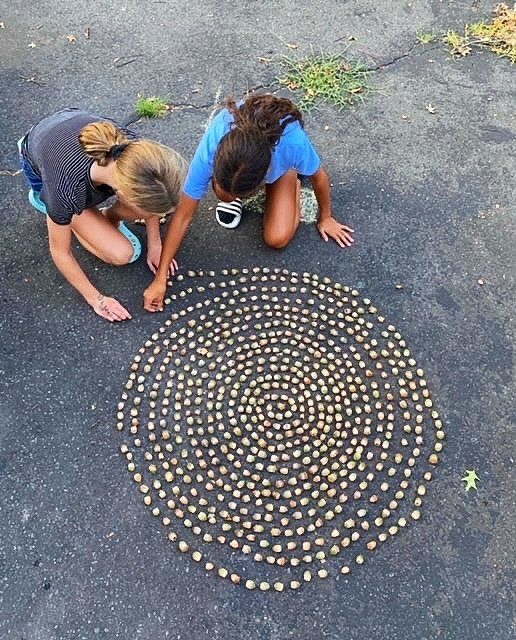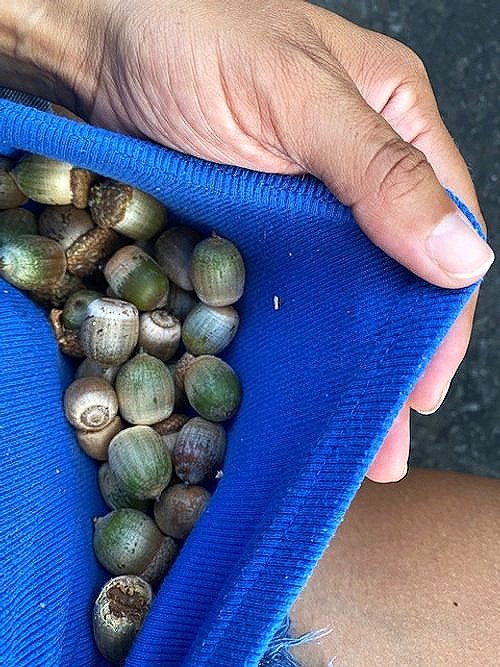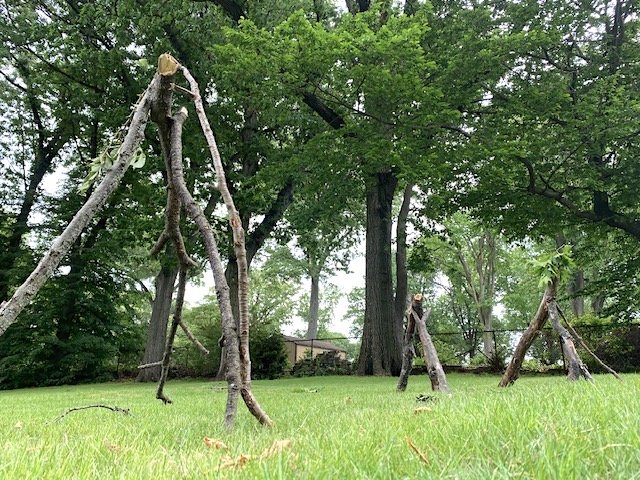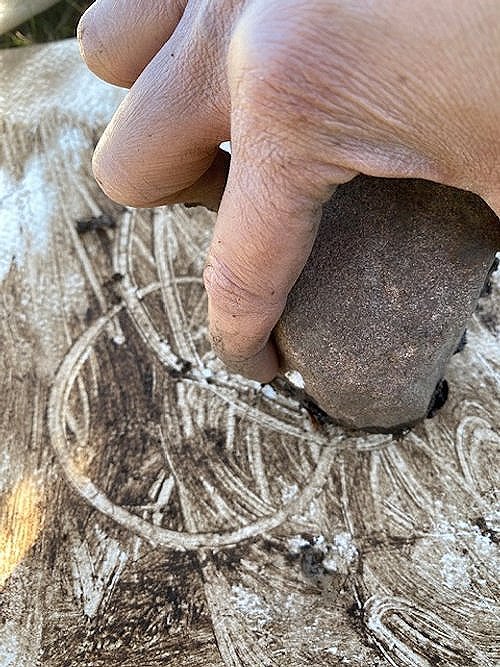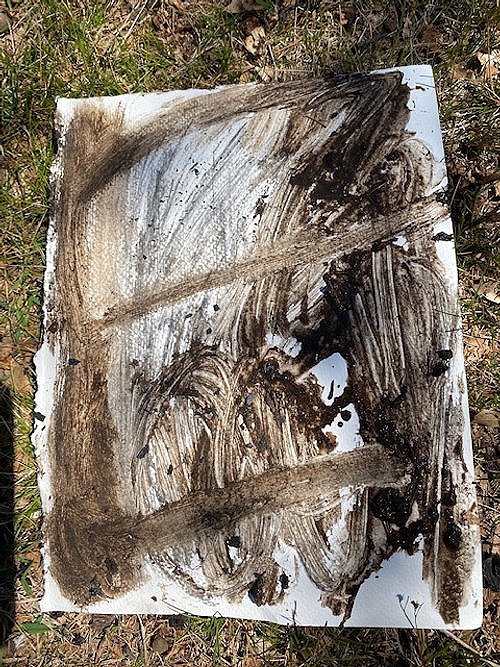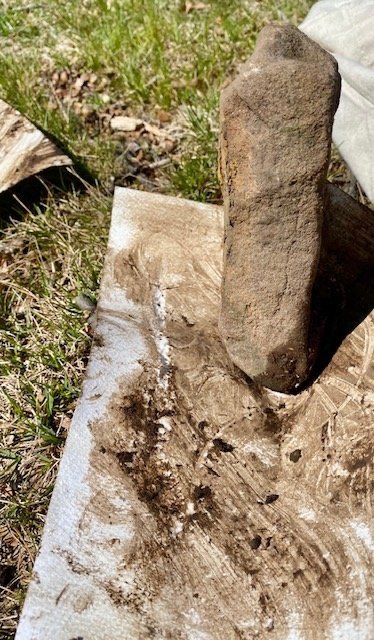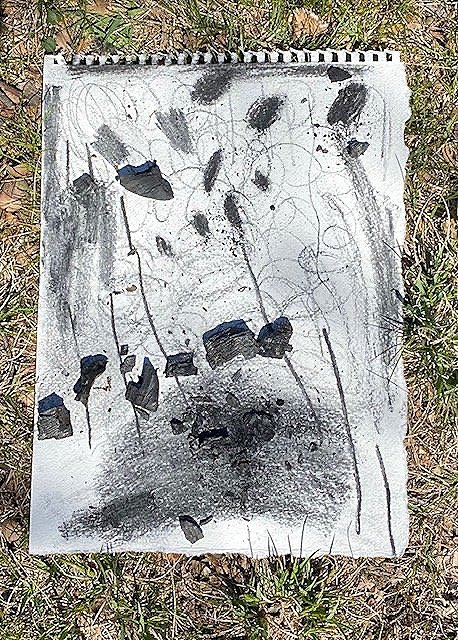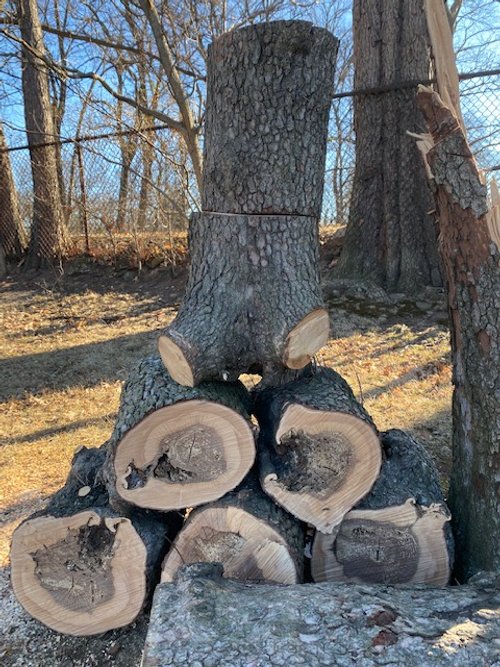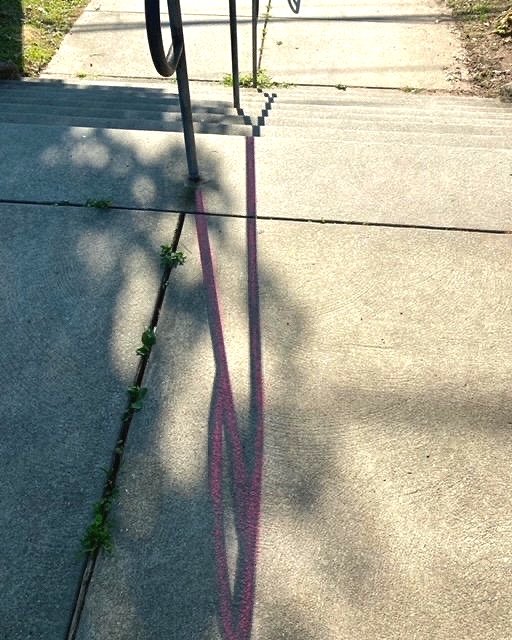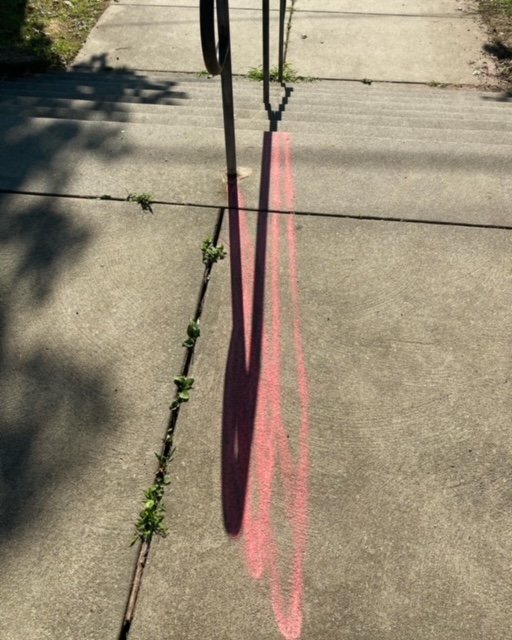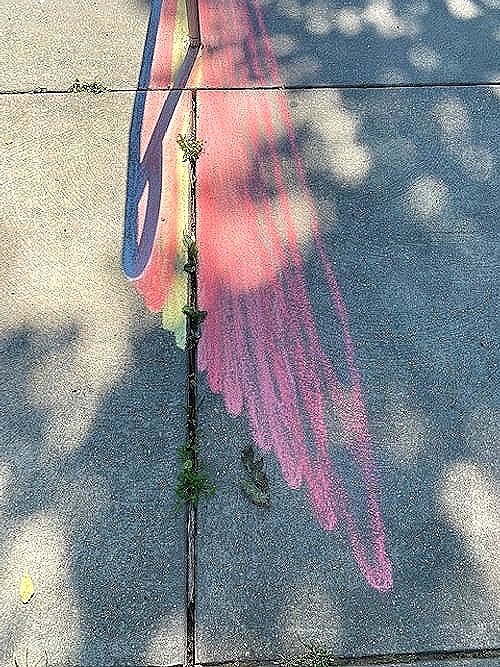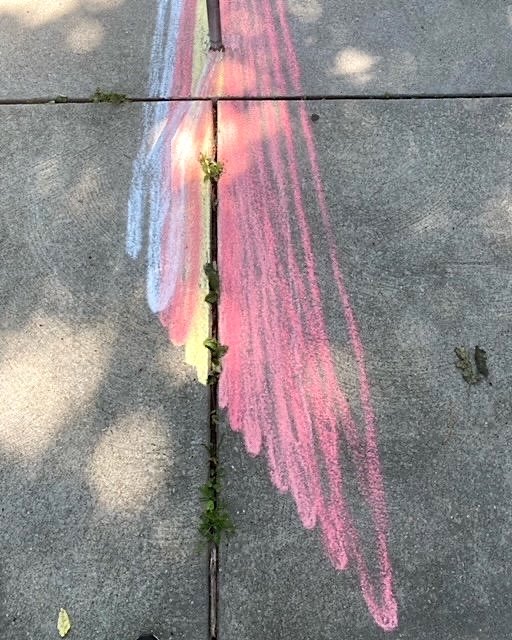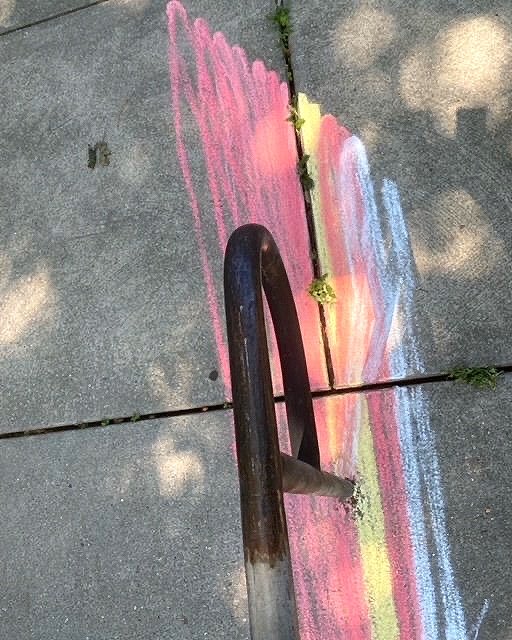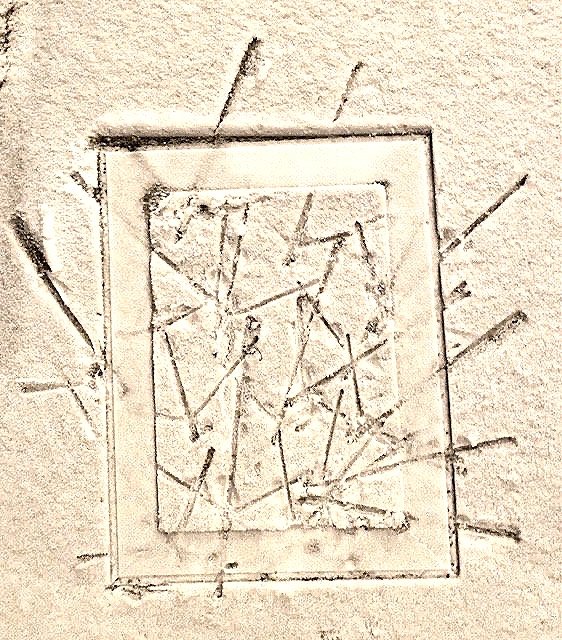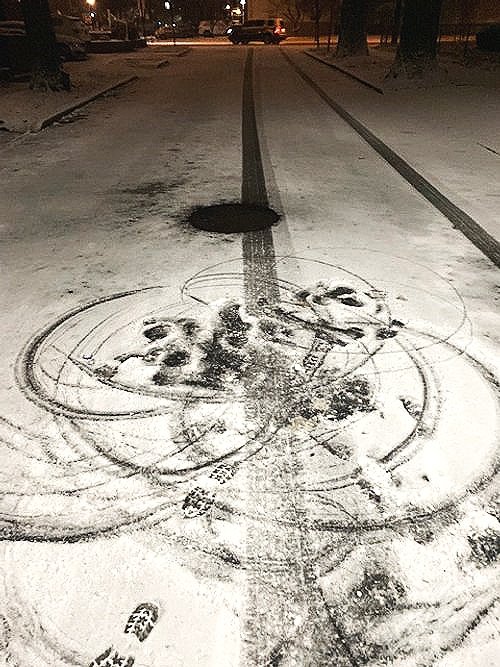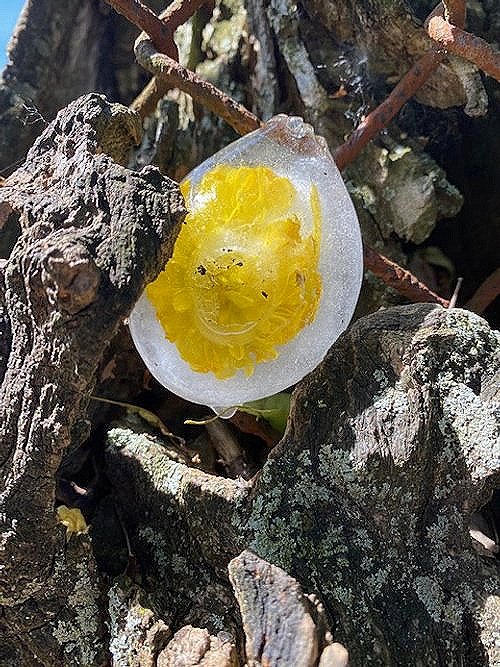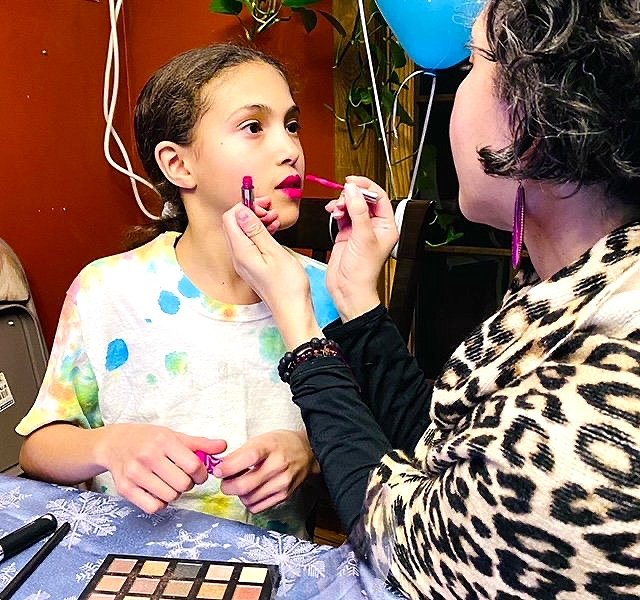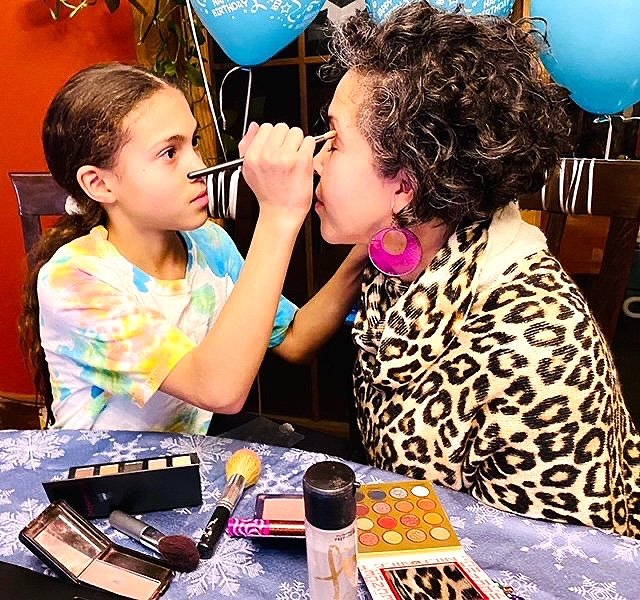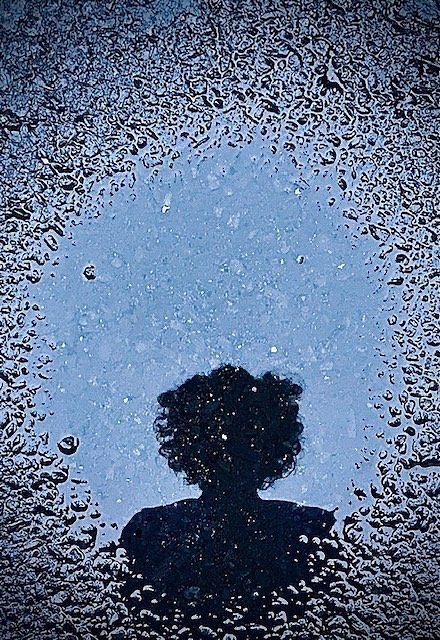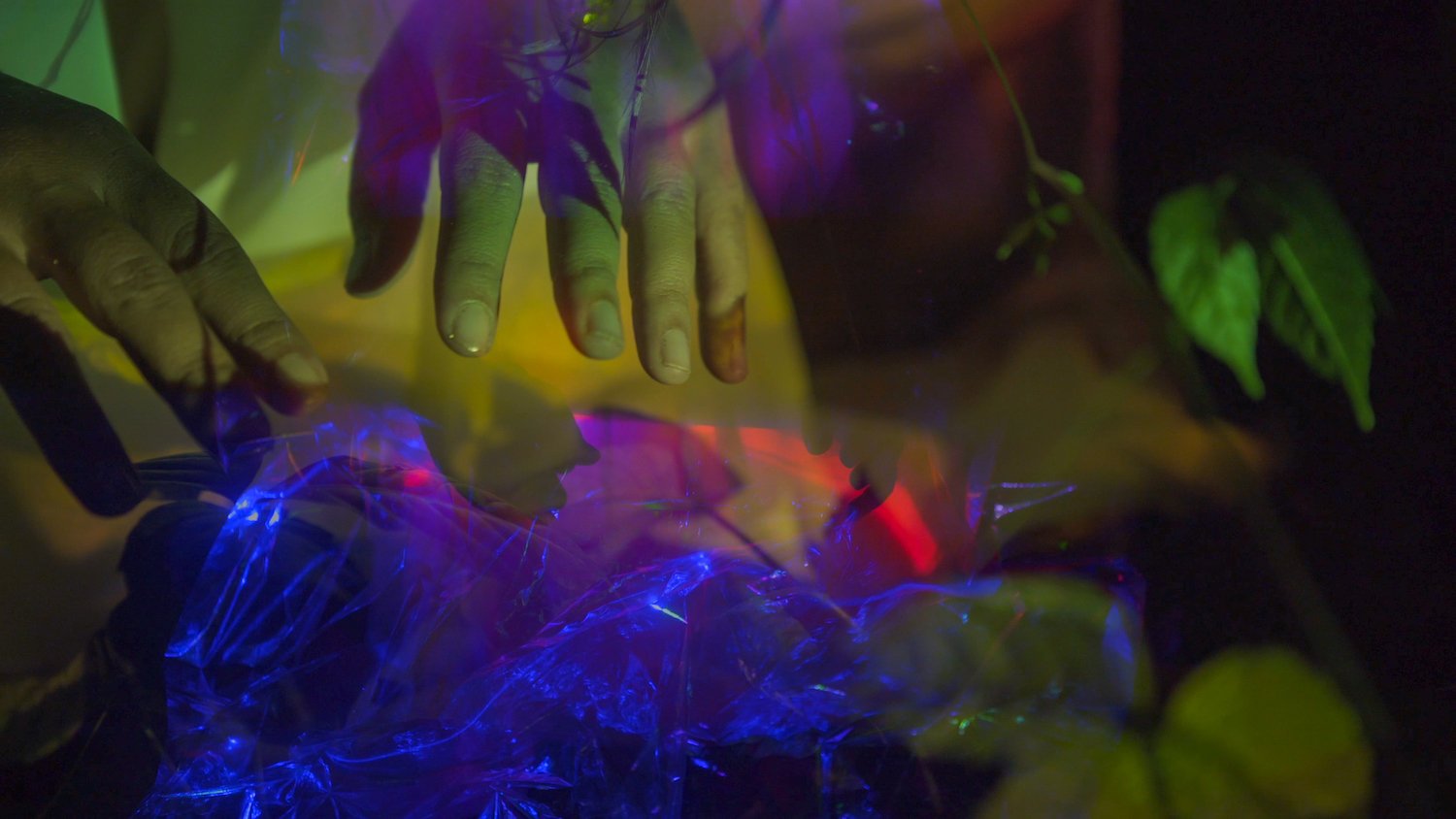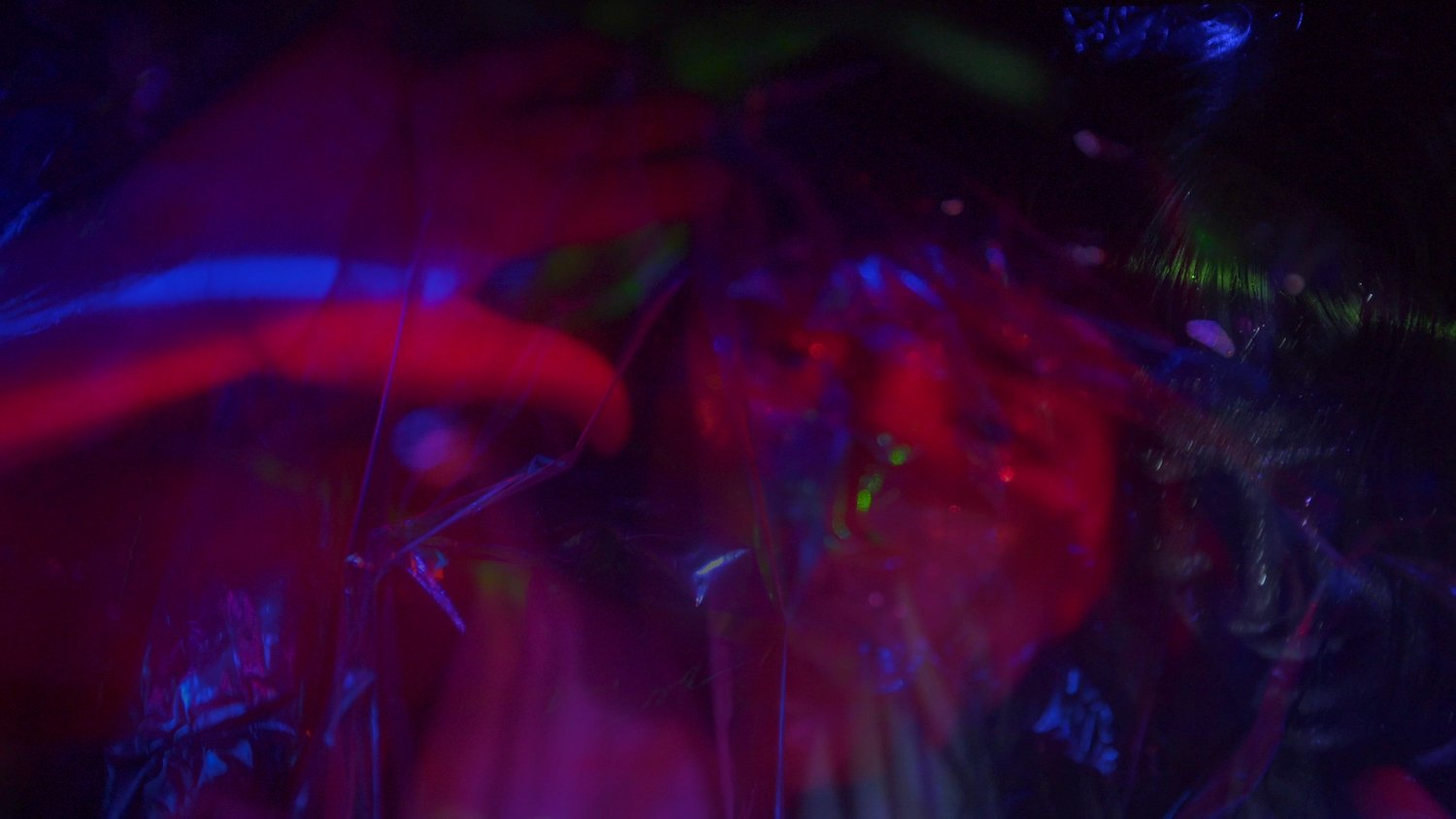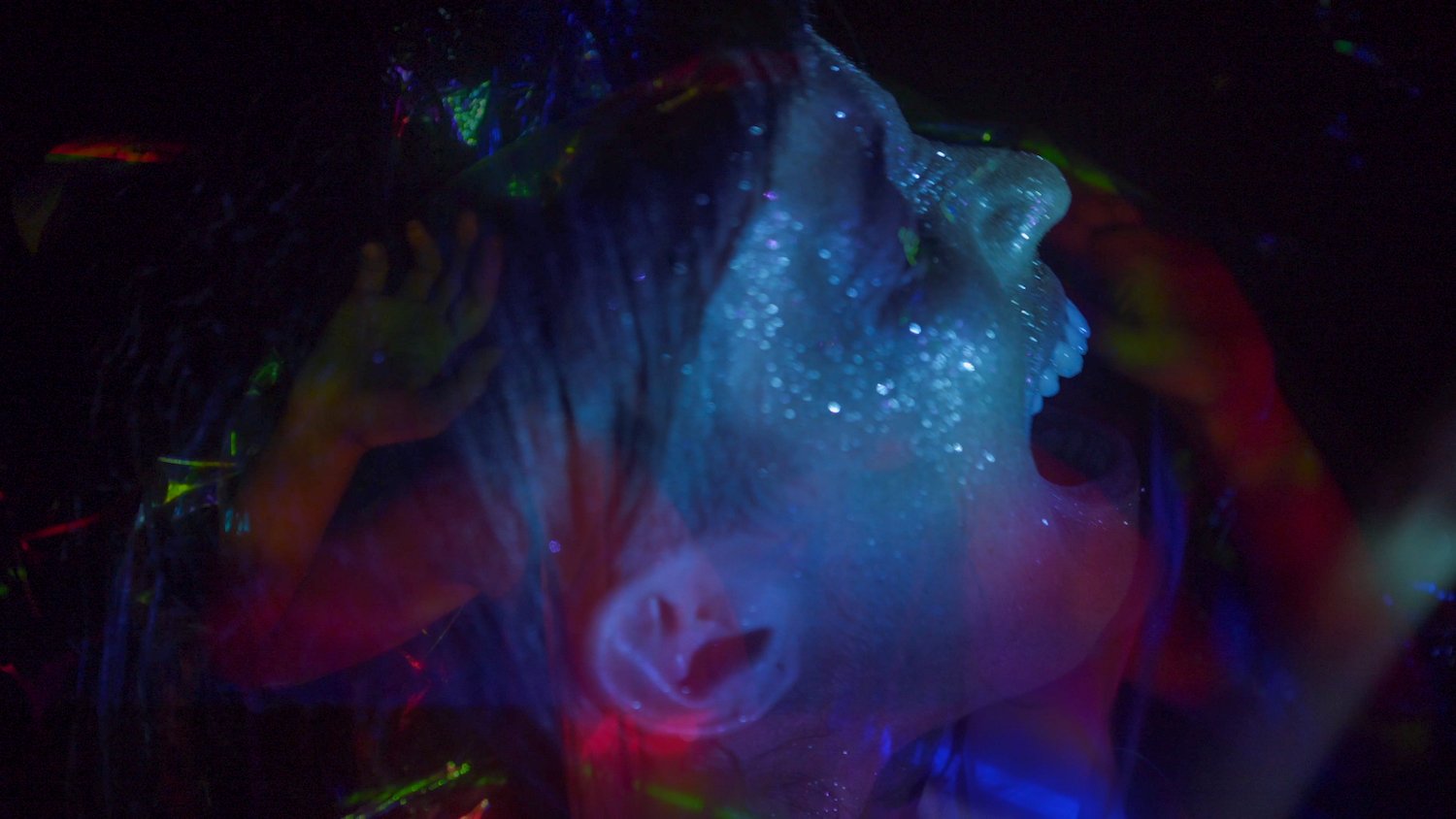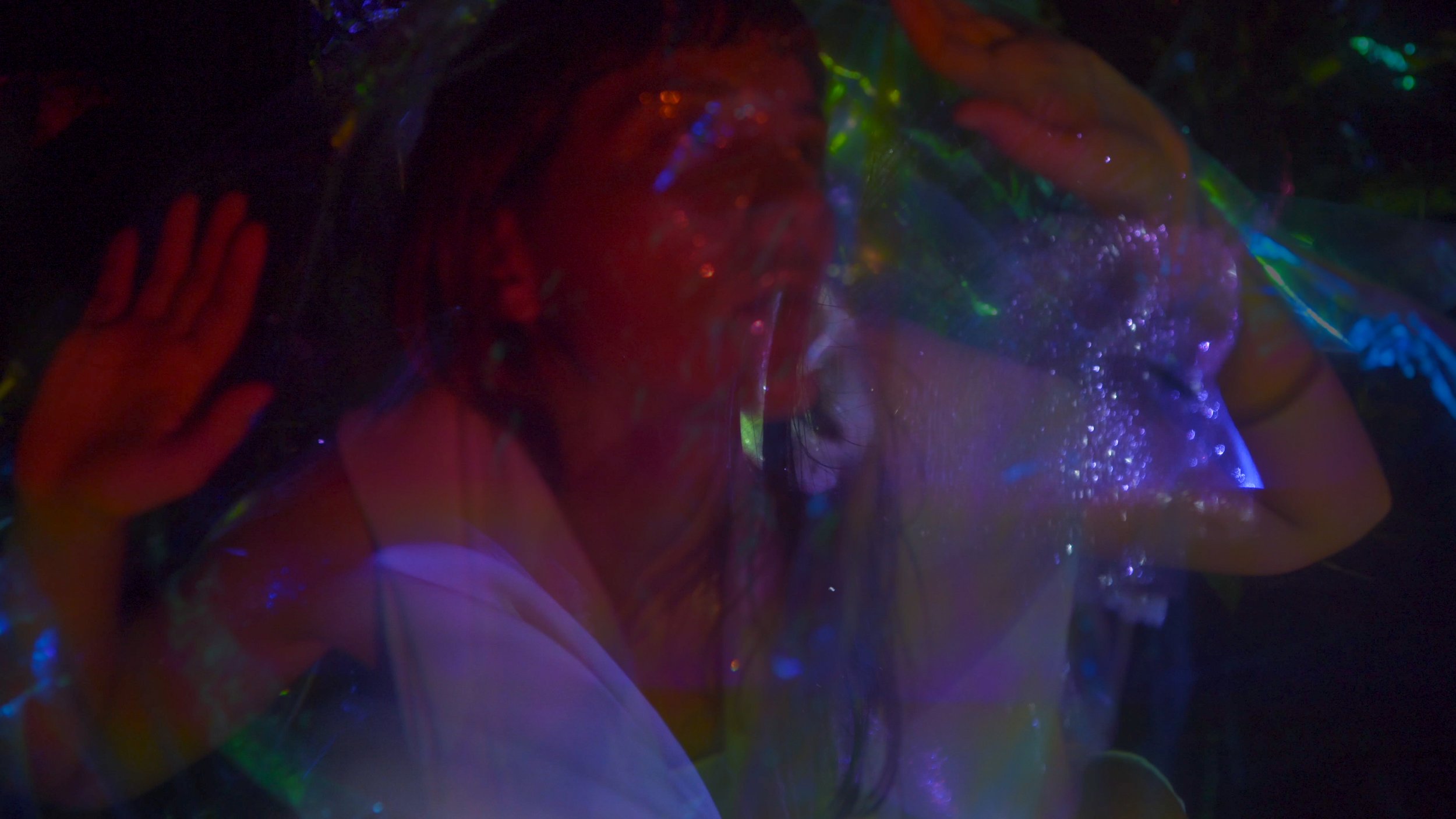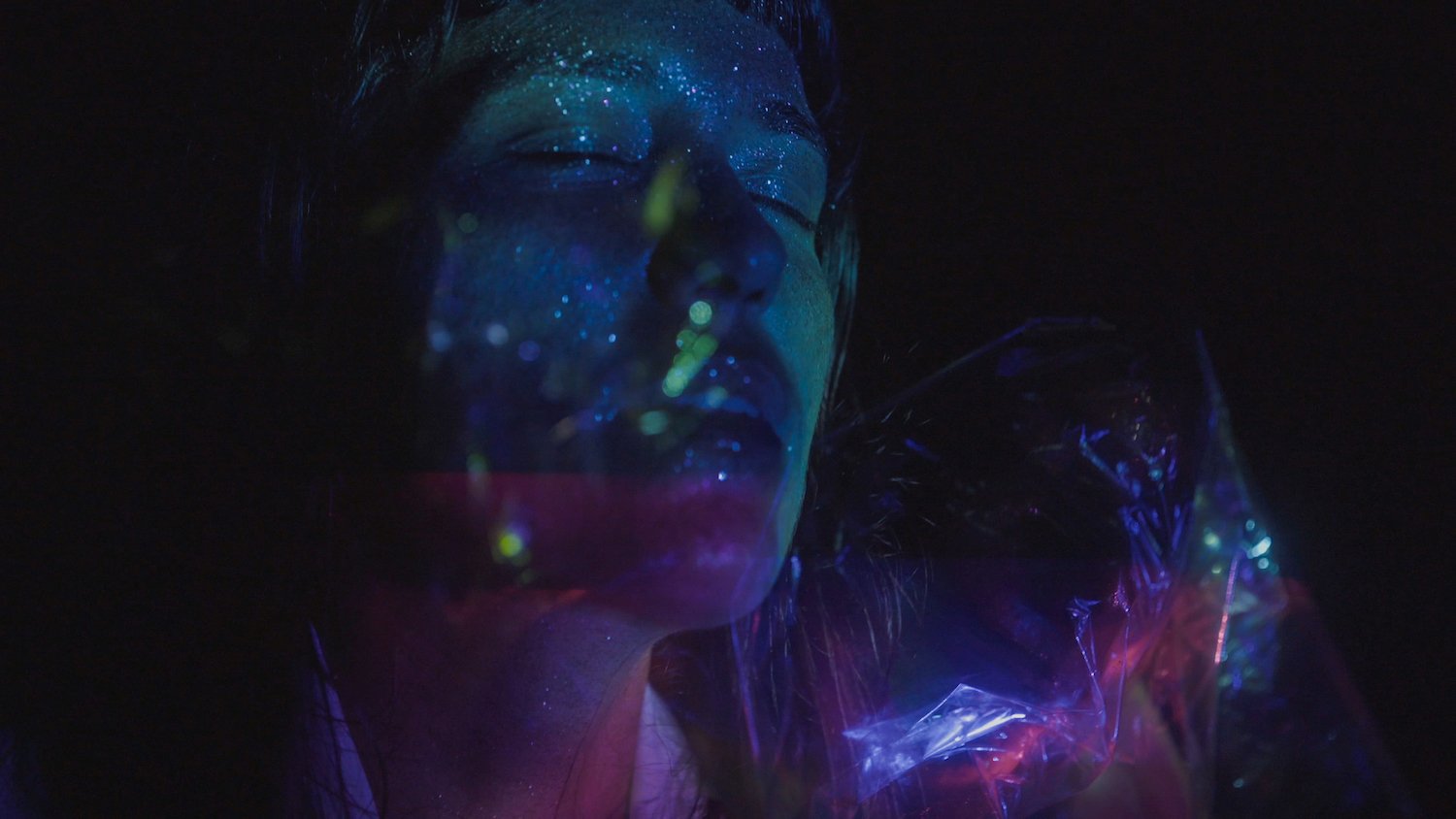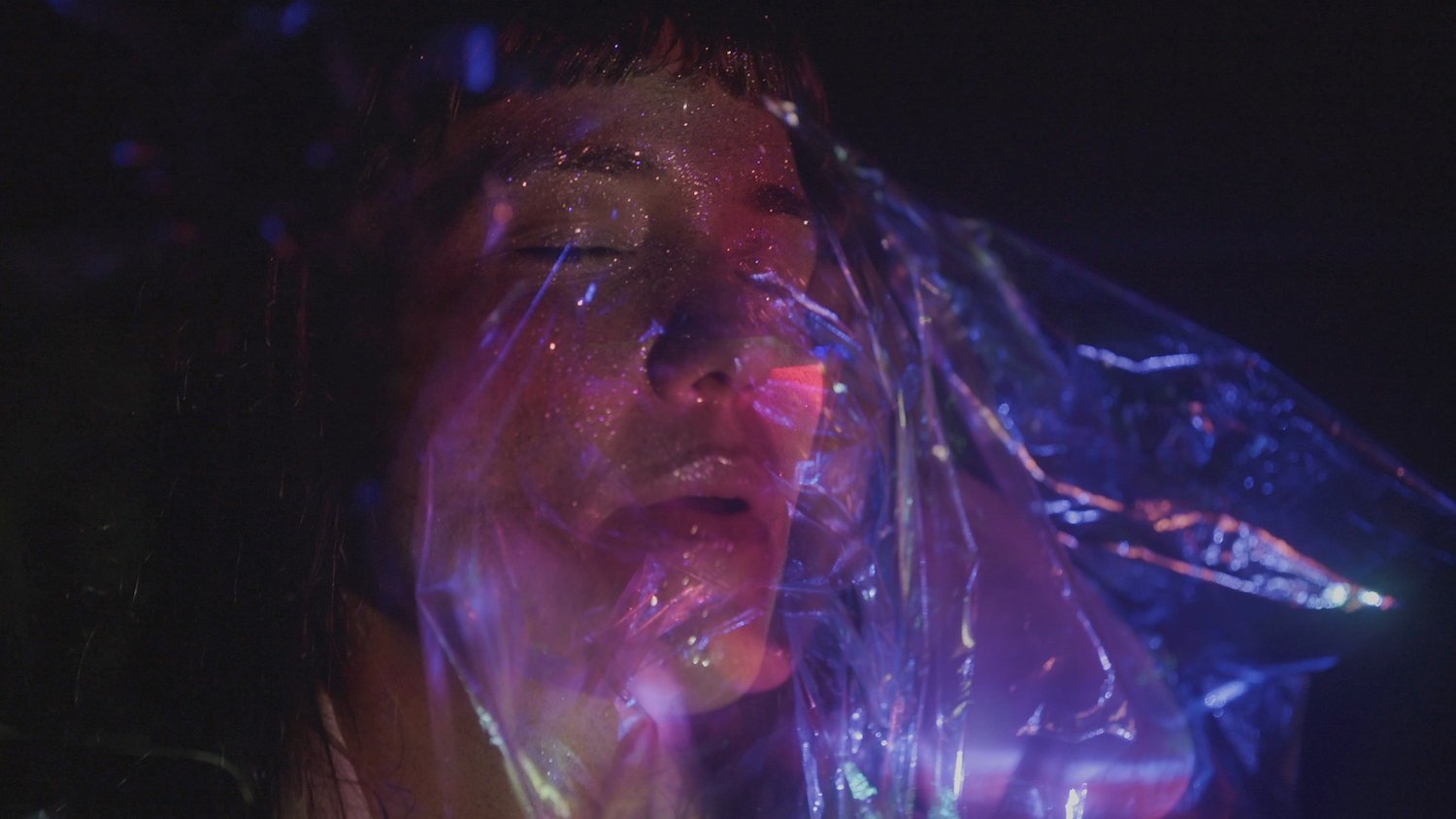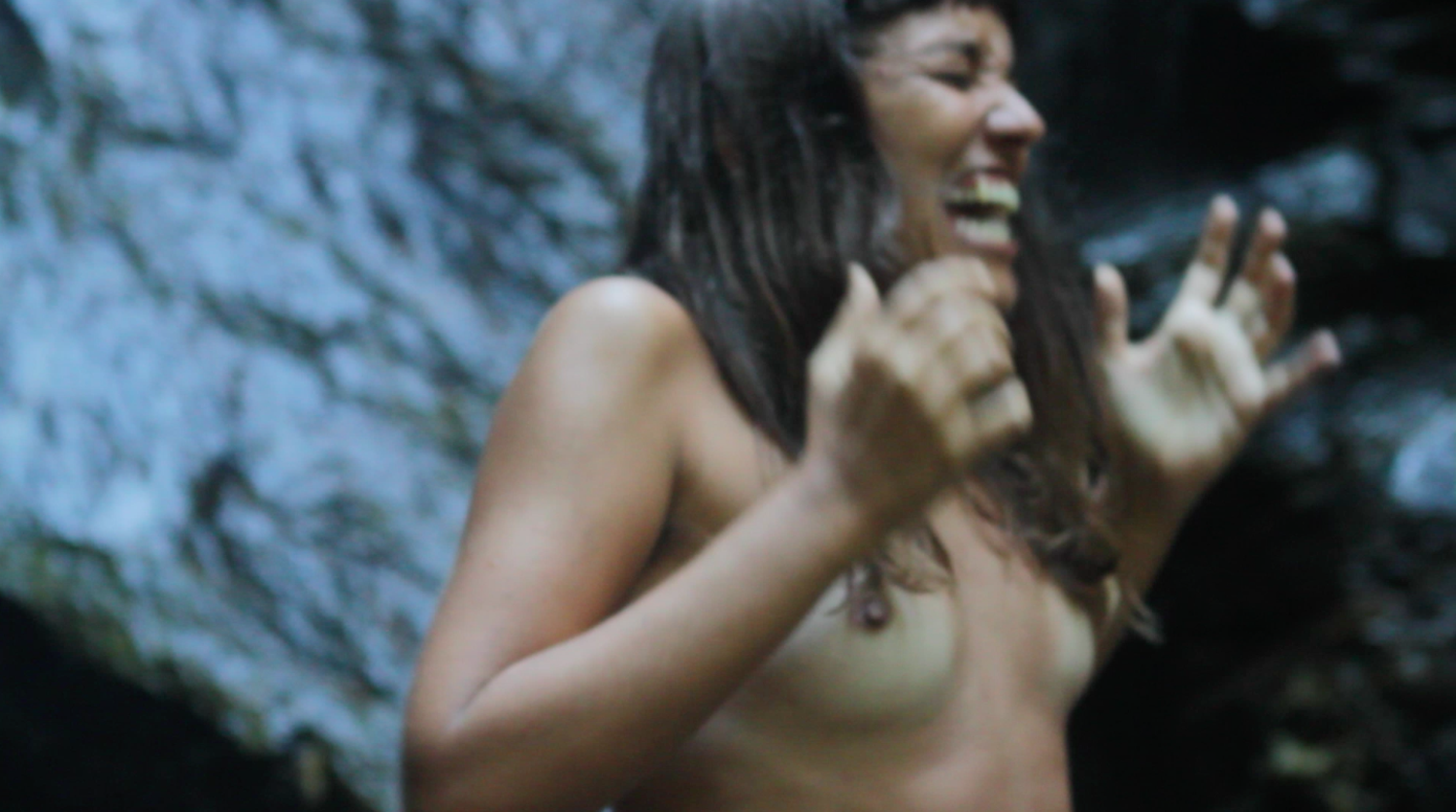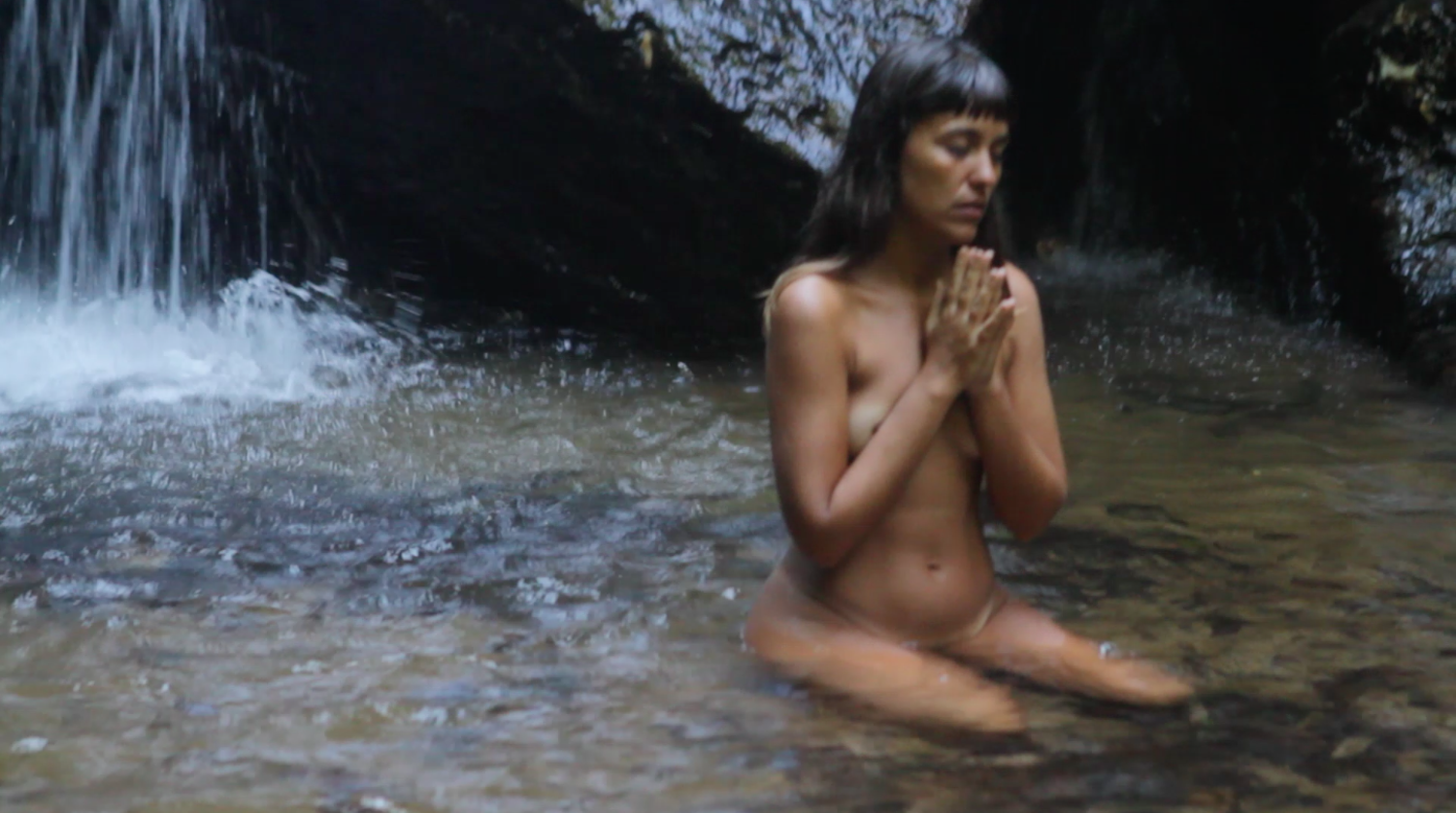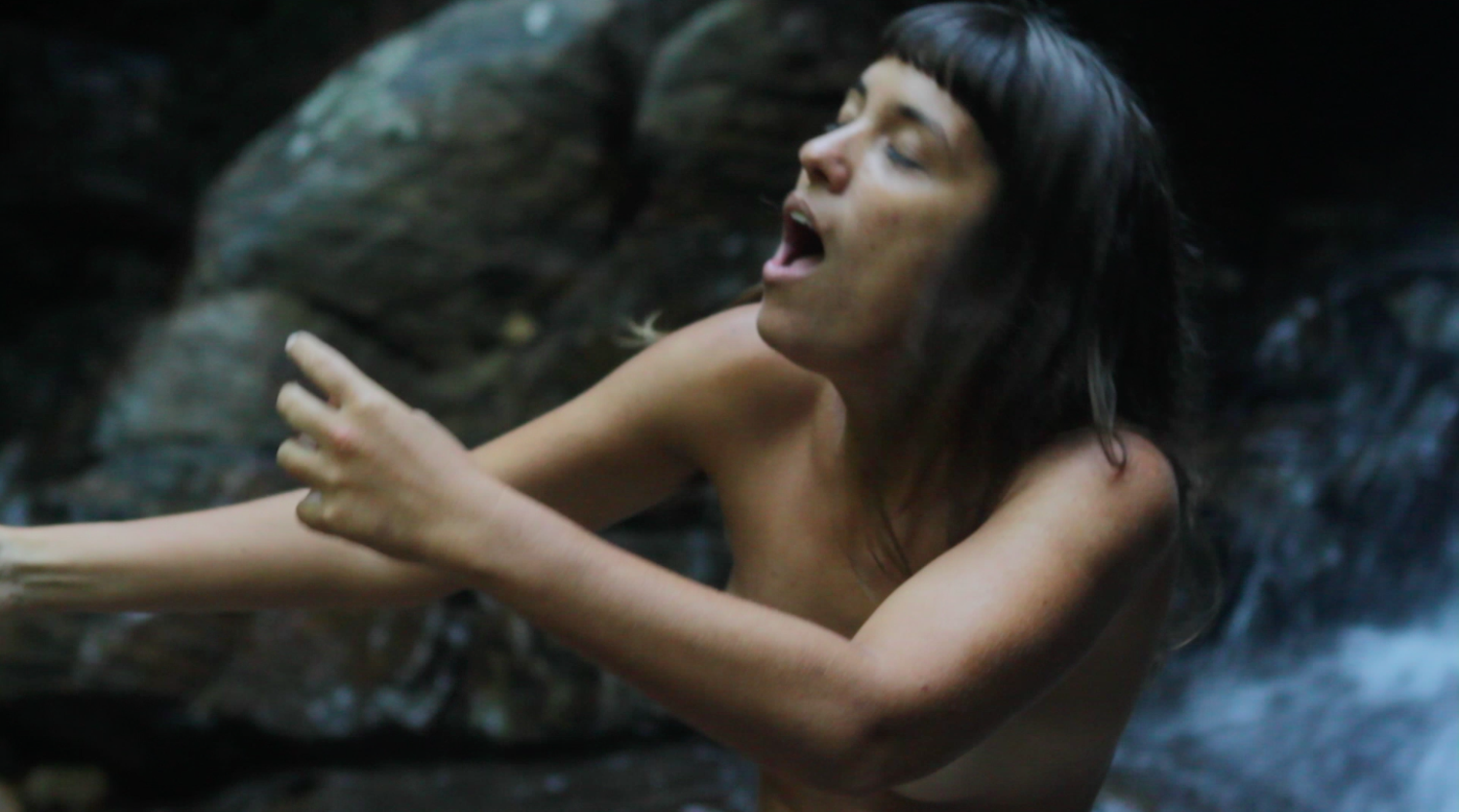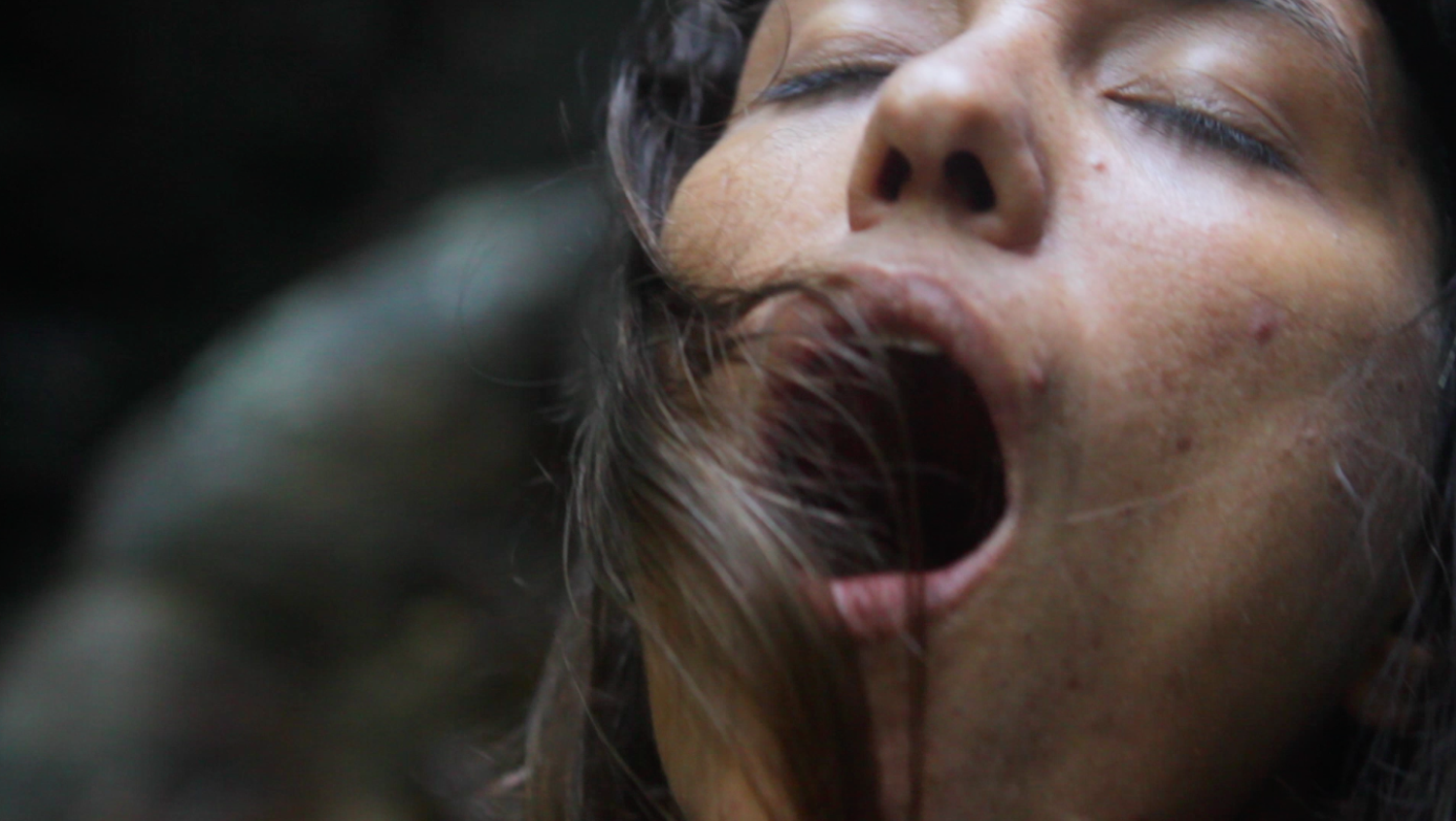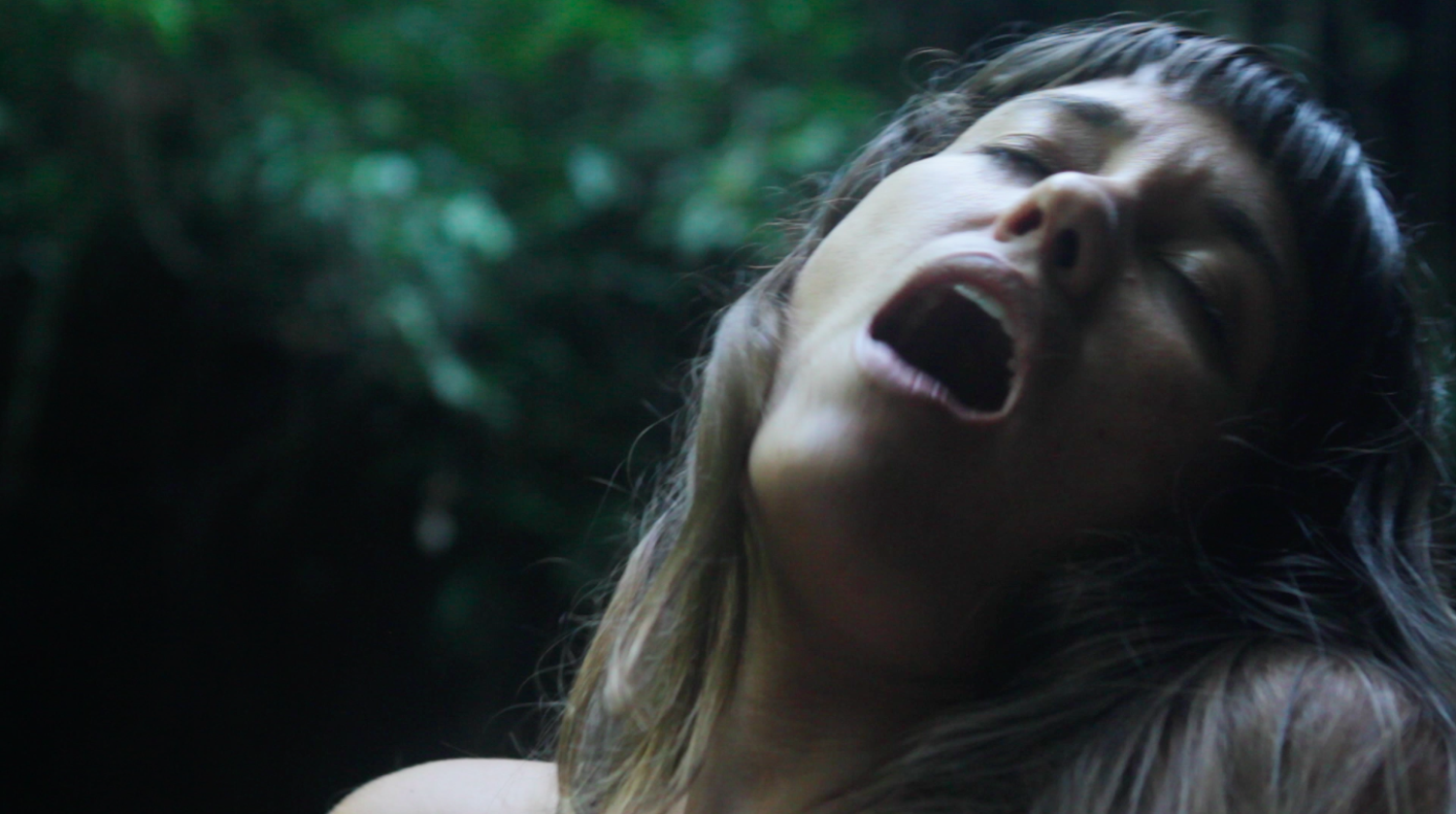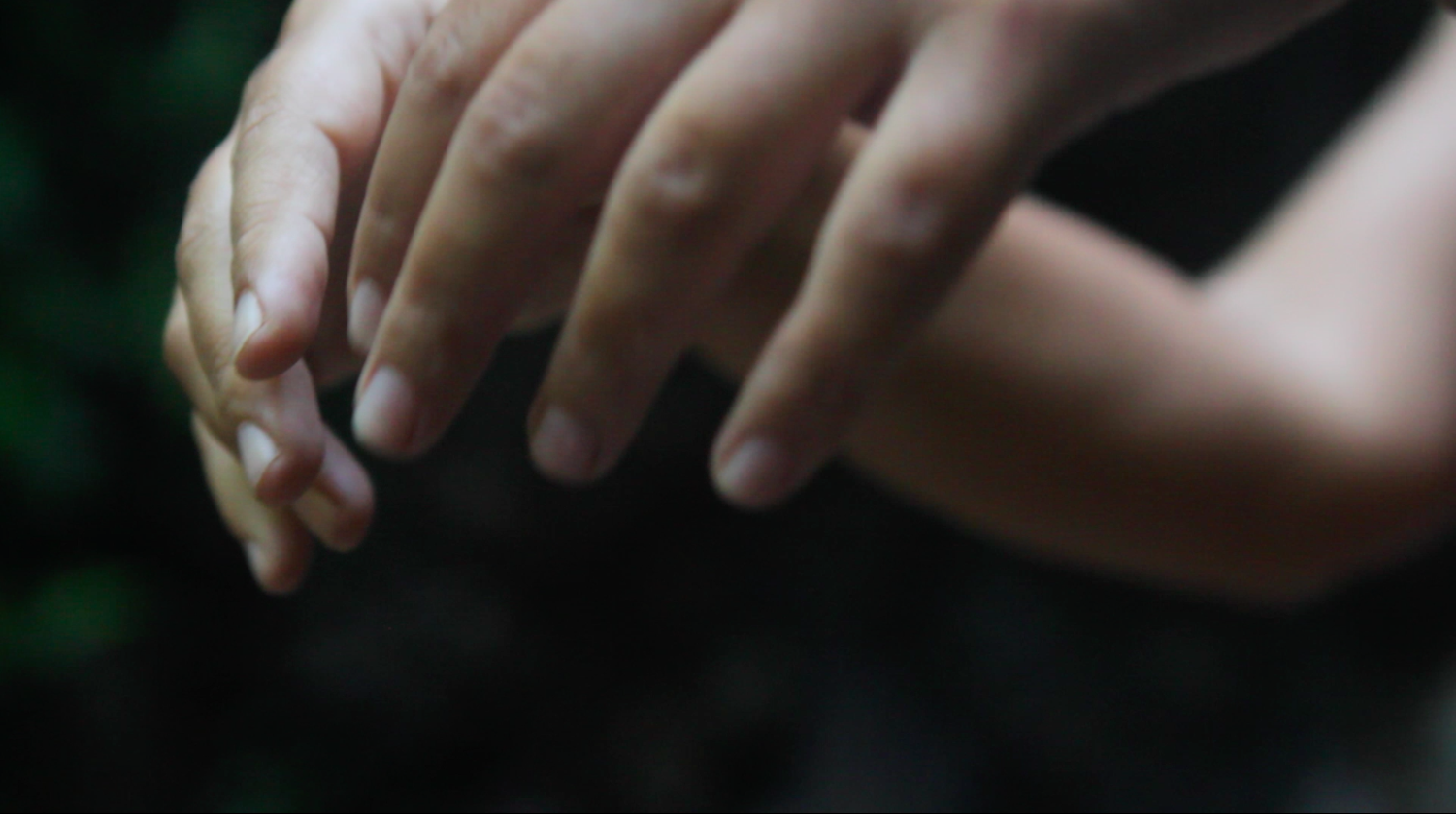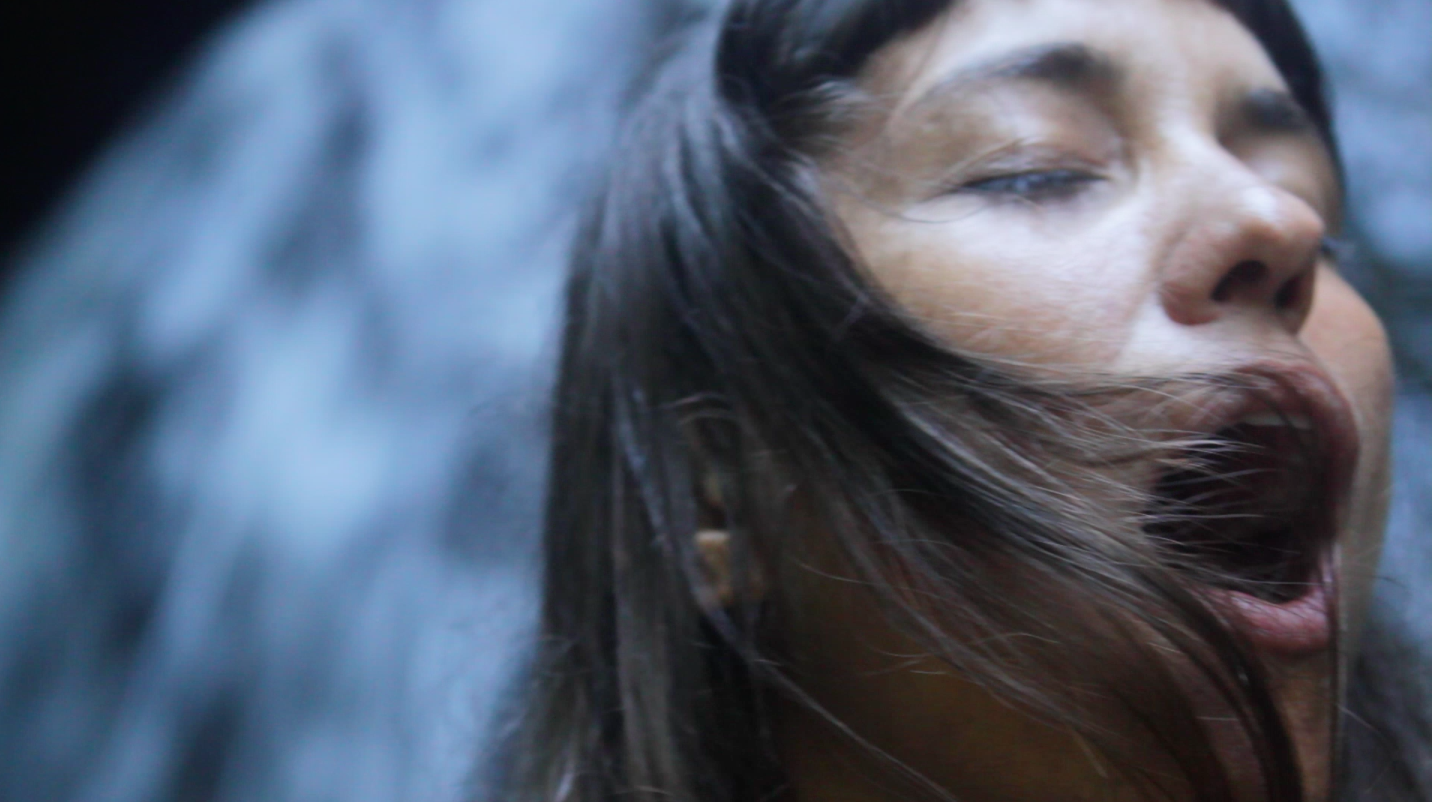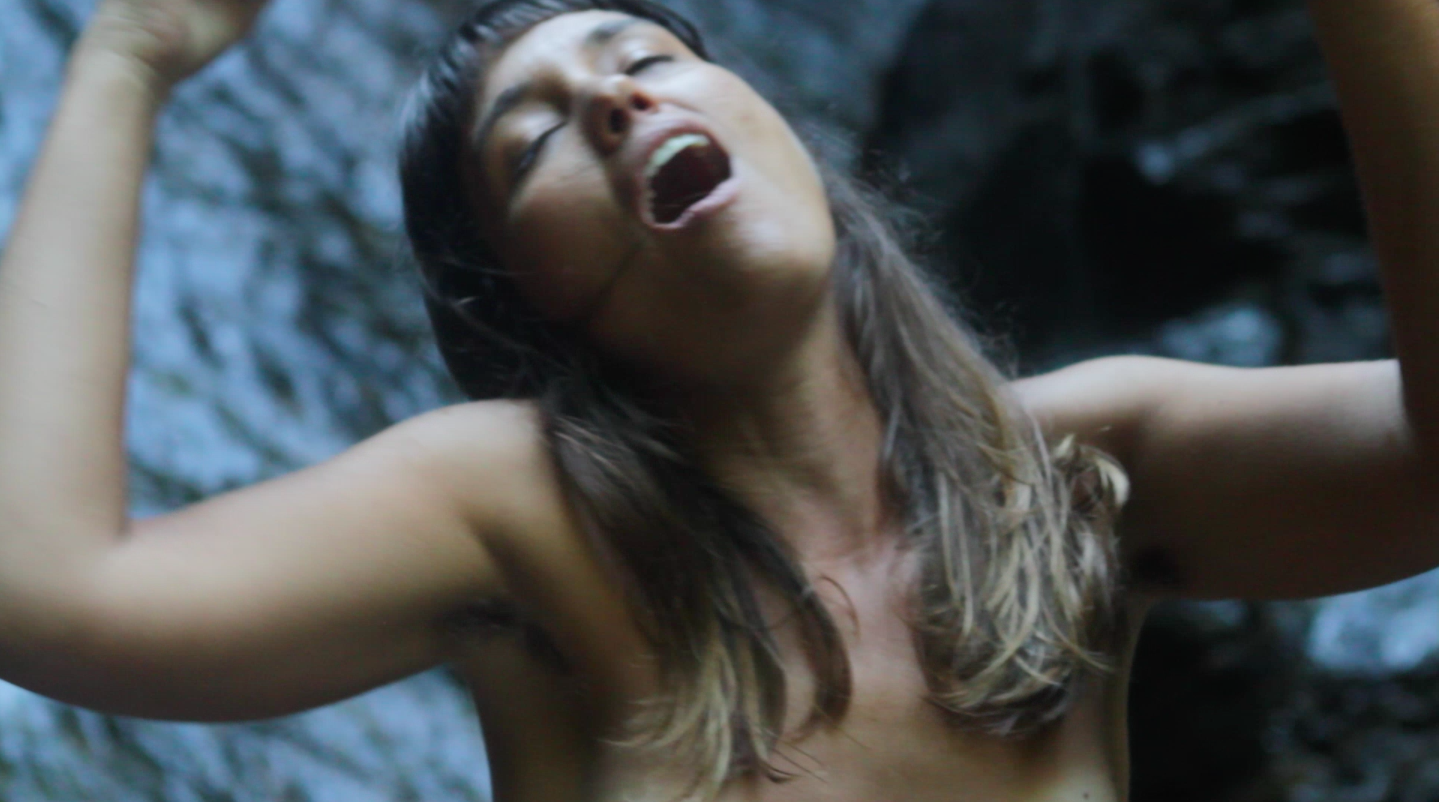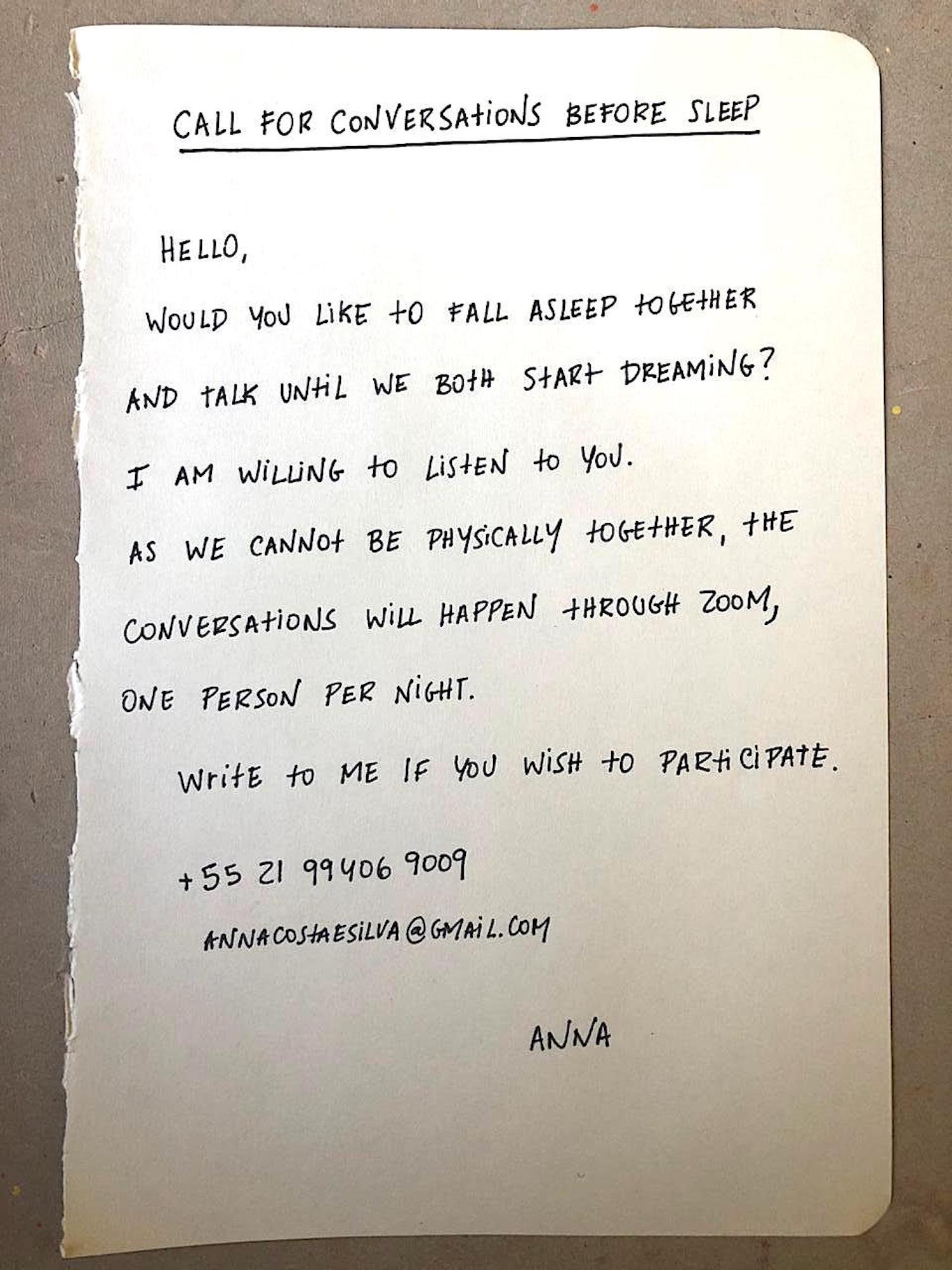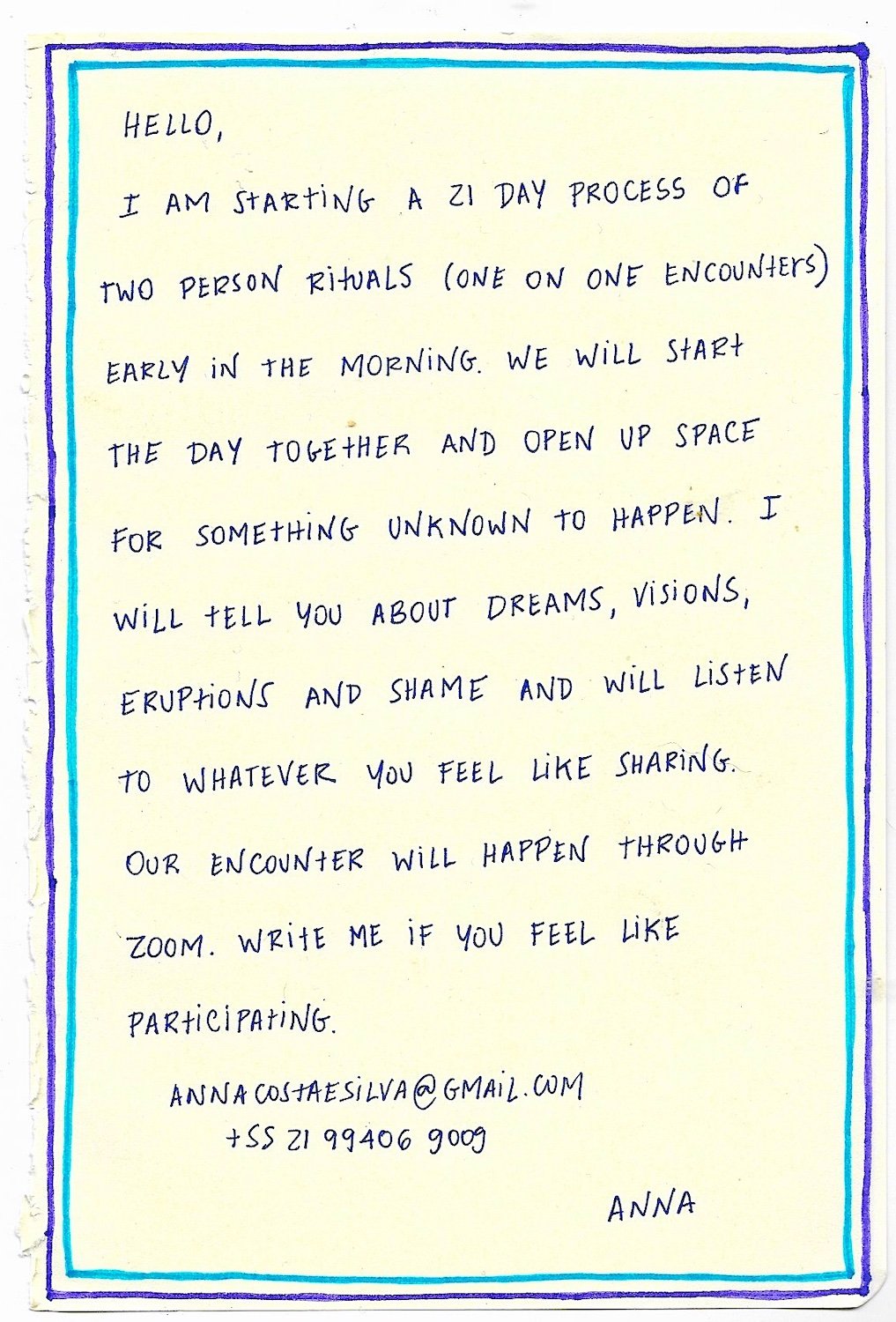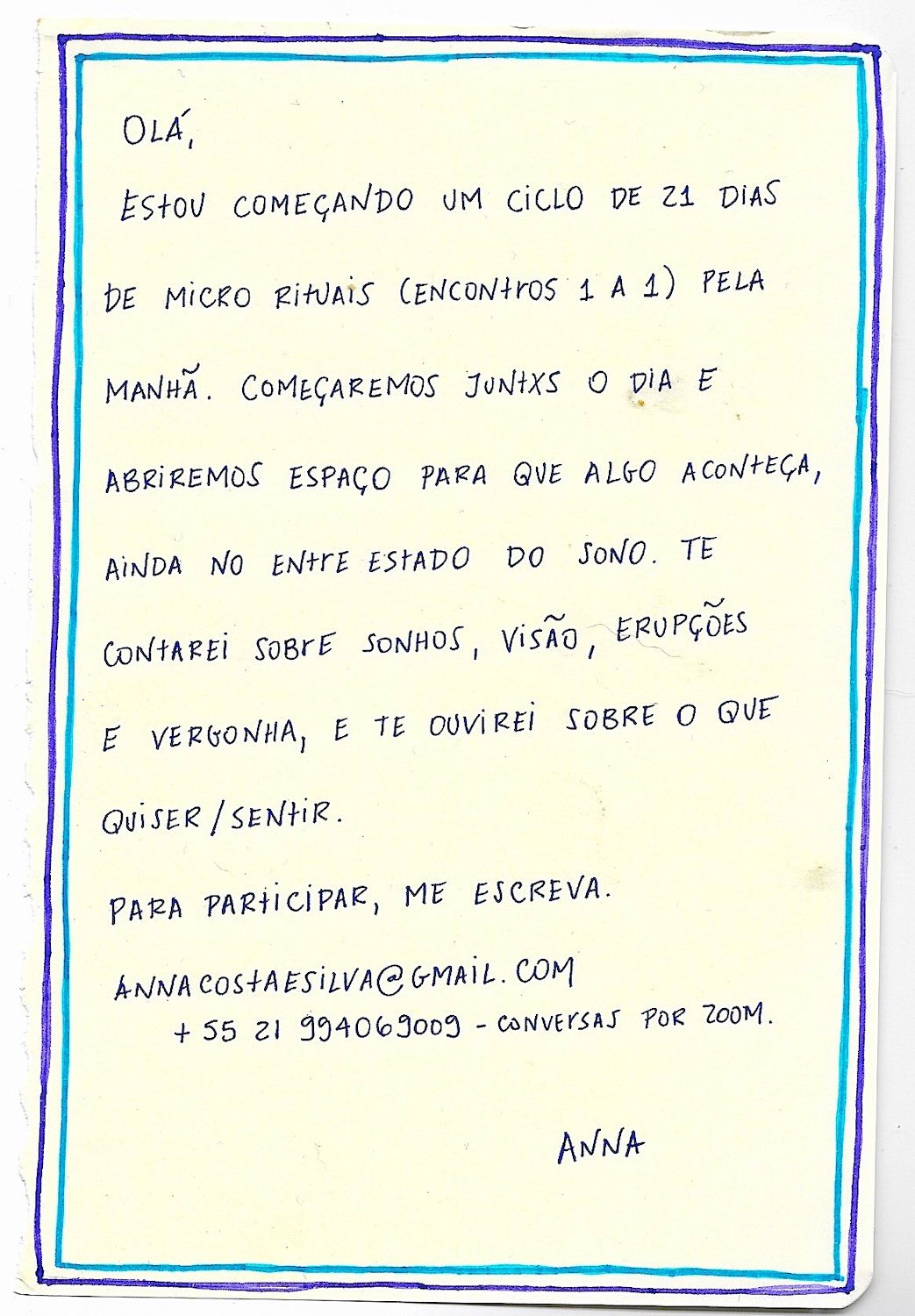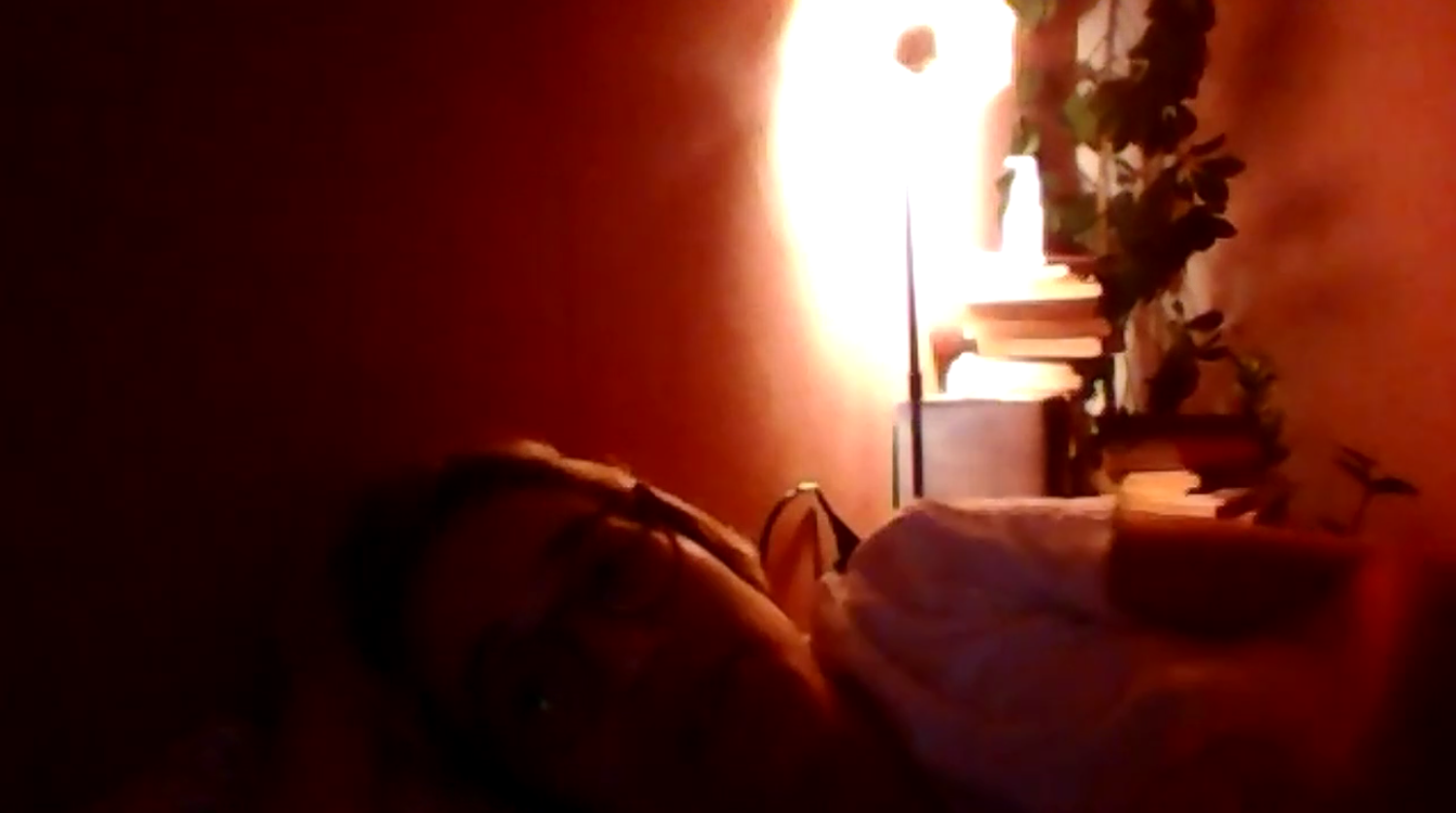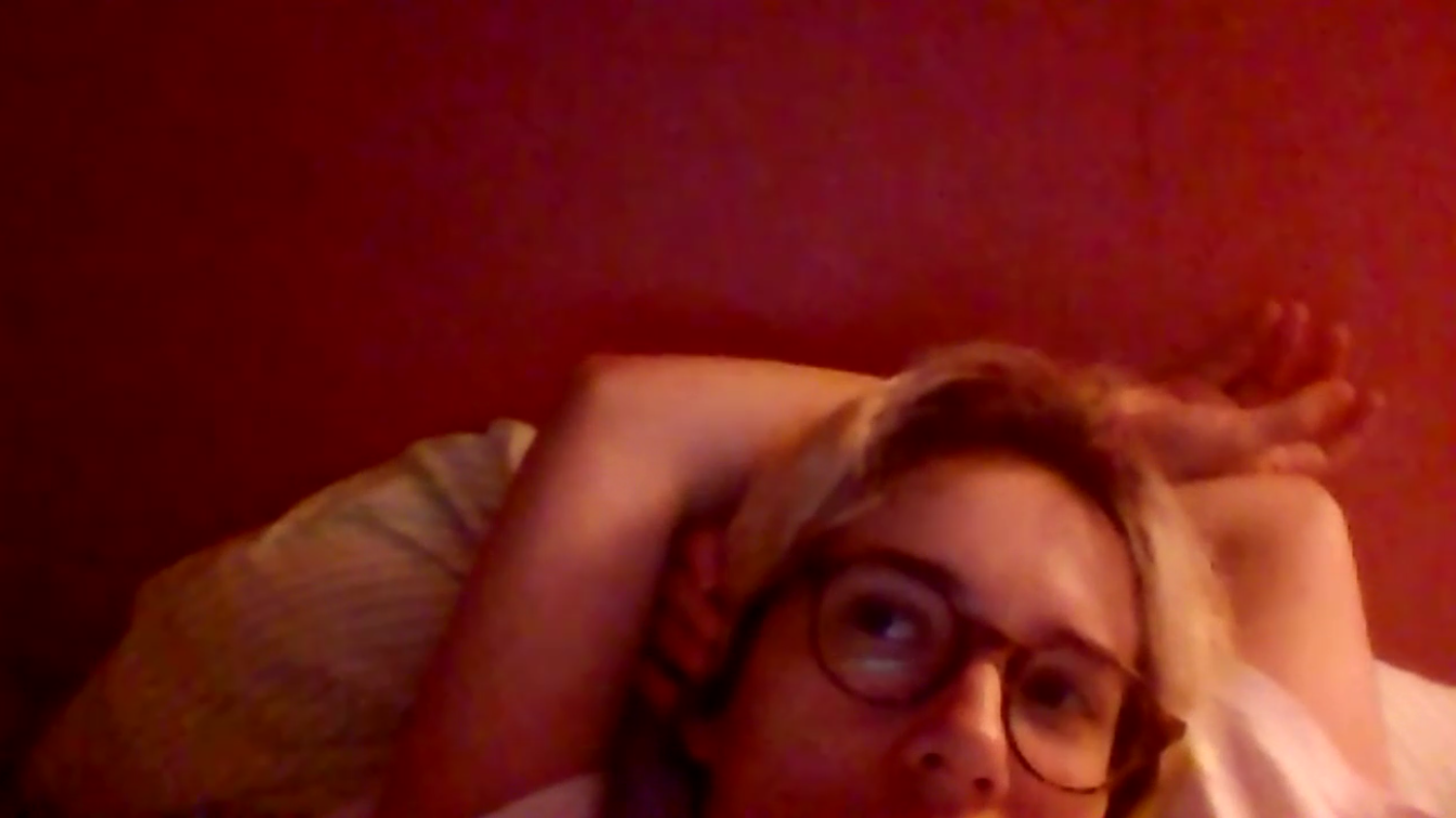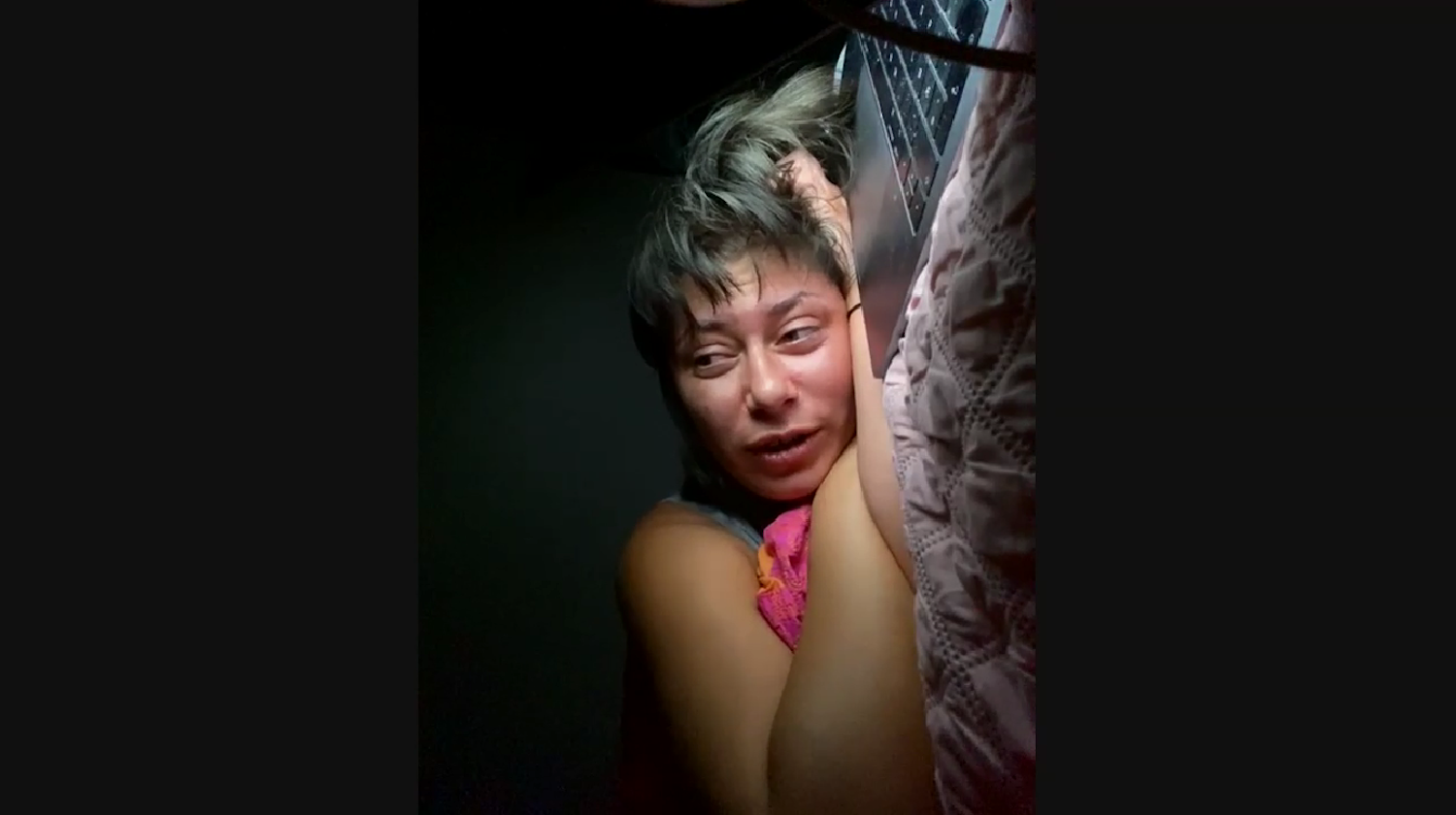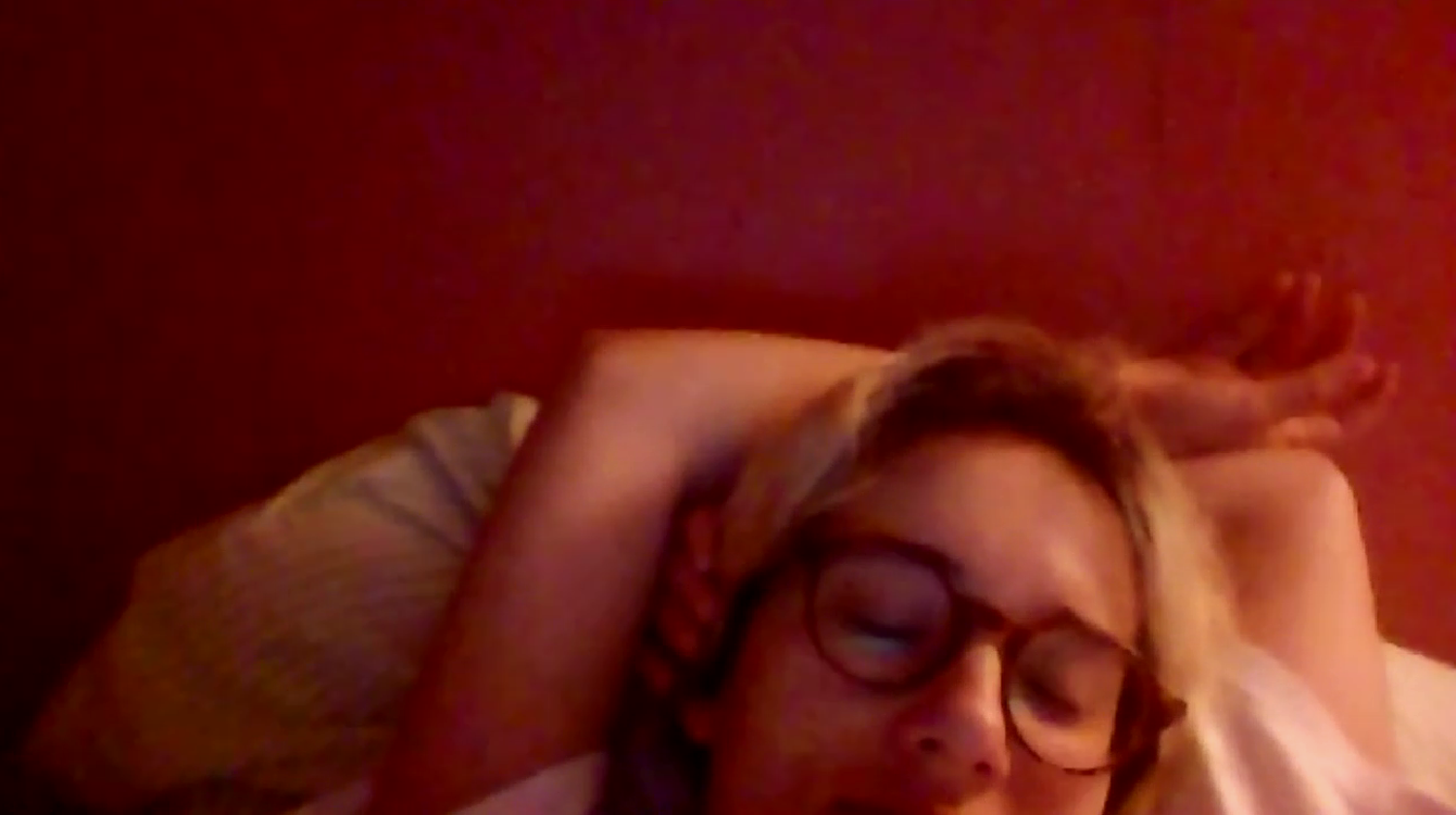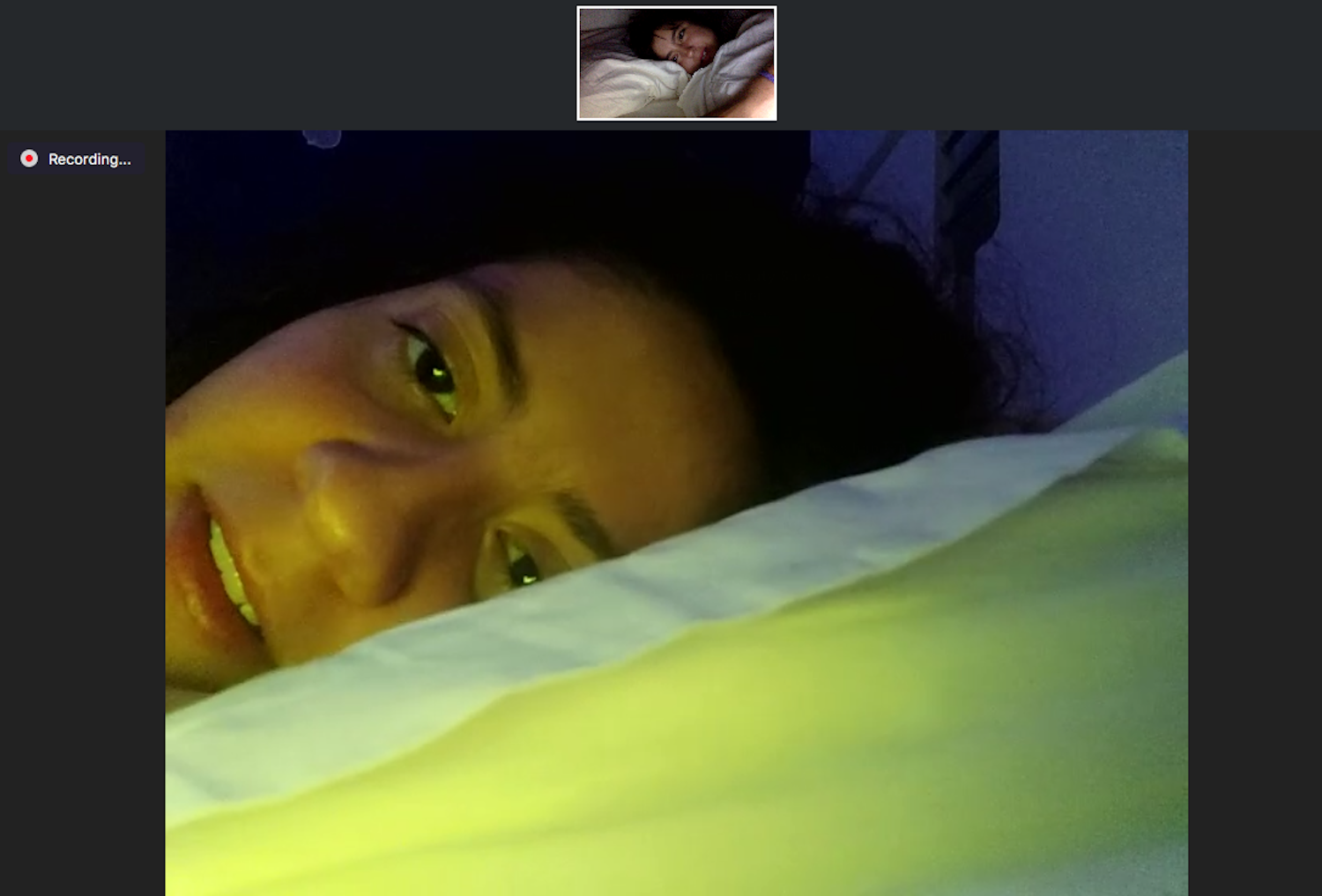Notes on the state of encounter
Anna Costa e Silva
Introduction: by the end of 2020, I found myself in a state of exhaustion and disbelief about life that reached an intensity rarely experienced. I have dedicated the last ten years to exploring the encounter as a driving force for the creation of art and life. Propositions that exist in the intersection between the ludic and the political, and that open gaps to experiment other perceptions of time and space through a field between two people. I consider my practice as the creation of partitures for living, or ways to orchestrate chance, which trigger intersections between existences in an imaginative and non-utilitarian way. It is a desire to invent worlds that do not yet exist and to inhabit states of presence, moments in which we realize that time stops, or that our perception of reality gets destabilized. My works take place precisely in this space between two and are only possible with physical presence – or at least that's how it was in the pre-Covid-19 world.
Among these works are Ether and I Offer Company, which exist in a hybrid art-life space, intricated in everyday life experiences, each in its own way. Ether is an experiment of conversations before bedtime, held in 2015 in São Paulo, Brazil; and in 2017 in Vilnius, Lithuania. I advertised around town and posted on social media an open call for sleepovers at any person's home who wished to host me and we would talk to each other in the moments before falling asleep. I would arrive at their houses late at night, and the conversations would take place in the dark of the bedroom. Together we would experience the last remnants of consciousness, gradually entering the intriguing universe of sleep and dreams. It was a very specific register of conversation, sometimes intimate and confessional, sometimes totally suspended in space-time, which gave way to unconscious, elusive, non-linear narratives. The conversations were recorded and, later, unfolded into a sound installation, presented in fully dark exhibition spaces with mattresses, where the visitor was invited to sleep, getting in touch with these narratives also in the state between sleep and alertness. At this point, the intimate experience, between two people, became collective; intimacies were placed side by side through a sound design, weaving relationships between each of the voices in the space. I have always been intrigued by the possibility of sleeping in exhibition spaces, and making this work, in a way, materialized this desire. I like to think of the projects as the creation of universes that don't exist yet, or especially, ways of being in the world that are different from those we were taught as correct.
I Offer Company, on the other hand, held in Rio de Janeiro in 2016, consisted of spending 21 days available uninterruptedly to accompany people in any activity they wished, beginning with an ad, placed in the newspaper O Globo and on social networks, “I offer company to anyone, at anytime, and in any activity. Moral support, bureaucracies, listening to crises, projects, boredom, missed tasks for lack of company, and others.” During this period my agenda was completely open, and meetings were scheduled in order of arrival. I performed with strangers from various parts of the city the most diverse activities that alternated between the functional and the ludic – a zone that interests me a lot. Accompanying a single mother in a DMV inspection and carrying her baby while driving, talking about life and impermanence in a cemetery, discussing feminisms while buying chocolates in a department store, negotiating debts in Serasa and noticing the music playing in the corridor, listening to secrets and talking about love are some examples of how we spent our time together during the 21 days. One of the most interesting possibilities that this project presented to me was to find daydreams, or what we could call "aesthetic experiences," in extremely functional and square contexts. The accomplishment of an artwork, in a silent and hidden way, opened gaps for other relationships with these spaces and their agents. There, it became very clear how the state of encounter could challenge mechanical and utilitarian actions of our daily lives.
The impact of social isolation on my practice was, therefore, extremely violent. The days, once blank sheets of paper open for propositions with people who chose me, became gaps of immobility in front of fragmented and rather artificial narratives, limited to the small frame of the phone. I was taken by an immense anguish, as I observed how the encounter became precisely the threat of these times. And the field between two people, that always moved me, became possible only through screens.
A year before the pandemic, I had dreamed that I was taking a "future course," held by videoconference, to learn how to live in a world without relationships. The professor told us that affections were dangerous and unnecessary for the functioning of the neoliberal society and that a new reality was imposing itself, "We would get used to it." I well remember the catatonic and sad state I was when I woke up from this dream, not only because I dedicated my life to encounters, but also because I realized that relationships are, yes, antidotes to the control of our bodies and, for this reason, "dangerous" to the capitalist system. Realizing the similarity between the dream and what we started to experience in March 2020 is quite frightening. The danger of contact, contamination as a threat, and the evidence of our perceived interdependence through disease are matters that touch me greatly and I believe will still take years to understand and process.
The question that seemed urgent to me, at the beginning of this "future vortex" of indeterminate duration, was how it would be possible to create non-normative strategies to get through this in a shared way. Rejecting the idea that was brought to me in the dream, that we would learn to live in a world without relationships, I believe that affections are precisely our shields, or "colorful parachutes," as described by Ailton Krenak in his wonderful book Ideas for postponing the end of the world. What could be experienced or felt between two people, even without physical presence? Was insisting on the encounter the only way to reaffirm these ambiguous, anti-productive existences, open to chance? In which way the ability to imagine worlds could help us digest this whole situation? If joy and the possibility of dreaming are important strategies of resisting authoritarianism, what rituals could we create so that the apartment could become an open sky?
I conducted two relational experiments during the pandemic: the video-letters exchange device To someone who is listening to me, started in April 2020, and the series of morning ritual-meetings Twenty-one ways of flying. The former was like a contemporary version of message in a bottle, exchanged directly by email between performers and participants, who signed up to receive video correspondences from an open call. The experiment, directed by me, was created and performed with Ana Abbott, Nanda Félix, Luciana Novak and Maria Clara Contrucci. We spent the whole year exchanging images, words and sensations in video with more than three hundred unknown people, who, in a certain way, entered our houses, in a shared experience of solitude. Twenty-one ways to fly consisted of morning rituals between me and another person upon waking up, during 21 days, via the Zoom platform.
I will focus here on Twenty-one forms of flight, gathering some reports that originated from the experience and that I called Notes on the state of encounter. This work was done during an online residency at The Interior Beauty Salon, curated by Nicolás Dumit Estévez Raful Espejo Ovalles. The project started with a call on social media inviting people to wake up with me through a Zoom connection, co-creating a small ritual to start the day, still in the state between sleep and wakefulness. The 21 days of this process happened in the last month of 2020, in a minimal performative proposal of closing a hard cycle and, at the same time, a way to invent beginnings, one day after another, through proximity practices. I chose mornings because I wanted the action to be like the opening of a portal to the day, still embedded in the dream universe. I would like to bring the dreams as pillars of this experience. Moreover, mornings for me have always been times of greatest mental anguish and confusion. Sharing the bed, even from a distance, could open other synapses for the start of the day.
I would wake up with a different person each day. I would start the meeting by leading a meditation, telling about my dreams that night, and proposing that the other person also brought some action that we could do together. I created a colorful mantle to accompany me, made in collaboration with the artist Marc Kraus, and I would ask each person to wear the color that represented their state of mind that day. Right after these meetings, I would set aside a stone from my altar as a gift for the person and ask each person to also set aside something they would like to give me, like a music sheet for the moment when we could see each other in person and exchange these amulets.
As soon as we finished the ritual, I would write short correspondence-reports, intended for each meeting. They were writings imbued with affection and also with sleep, with the state of suspension that those intimate conversations provided. I chose to write in first person the messages received from the portal that was opened, bypassing and giving back to the other a little of how our time together reverberated in me. I don't intend, with these reports, to explain an experience that only exists between two people. But, by bringing the texts together, I believe that other imaginative possibilities emerge and that the writings themselves can operate as some forms of flight.
Day 1/21 - for Marc Kraus – color: white
When I look at you, the image that comes to me is a lion. In a white robe and under the purple light, you tell me that love is the greatest tool and that you are investing in it. I also feel that throughout our lives we have been carrying around mismatched socks, as if someday we would fit them together, but we don't. And no one has told us, even, that life goes on and on and on. And that continuity can be, in equal measure, flux and oppression. When you tell me that you have been collecting shards, I think of an image of what would happen if we put together all the shards of all the people in the world. Everything that we have been spreading around. And that would be beautiful and sad. How precarious we are. And how we can cause hurricanes in the lives of others and have no clue. We don't know about the many narratives we participate in, and sometimes everything is fine. Even if the synchrony of singing voices never happens through Zoom – and maybe that's a perfect metaphor for infinite distance – it's beautiful to see you move seconds before. The screen turns off, presence and absence play a strange game. I miss getting lost along the way, or entering a wrong street, dazed by the echoes of our encounter, and yet I am home, still.
Day 2/21 - for Ana Abbott – color: black
At the end, we return to the beginning, and I think about how birth and death permeated our entire encounter. You ask me to guide you to sleep, and I think of the enormous beauty and trust in this gesture, to build a field for someone's sleep. It is like holding hands and letting go until the other walks alone. And it' s the cycle, the force that moves mountains, the sun that still shines on the road I never passed. And how many things we have gone through and the many you tell me and I don't even have enough repertoire to imagine. But these times have been about the unimaginable. When I look at you in this robe, I see an old woman and a clown child, and I think of the golden thread of life as you tell me of the pearly seventh dimension where there is everything that exists. I also feel that this year is a great fiction, but it is interesting, after a while, to connect the dots. We don't control anything. And the effort to avoid it is perhaps one of the most painful things in life. What are we protecting ourselves from? To what extent do relationships become dangerous? All the times we've been too big to fit, all the times the glass has overflowed. With a dog as a blanket, you tell me that it is possible, yes, to make a chain to fly. And that it is done by spinning it.
Day 3/21 – for Carolina Luísa Costa - color: yellow
You tell me that the sea is a mirror that points outward and the river, a mirror that points inward. Introspection and eruptions. Every outside mirror is an inside mirror. And it is beautiful to think that there is always a point where the river meets the sea. Your presence is yellow, it is d'Oxum. And when I look at you, I feel like I am in front of a wise child, an invitation to wonder. Like when I step on a pier and feel the waters of all the rivers and tides of the world reverberating in the water that runs through my body. And I think, too, of the many organisms that today struggle to keep breathing. George Floyd's last sentence was: "I can't breathe." Humanity, today, suffers from lack of air, and the air is missing in a different place in each person. Where do you lack air? You tell me about the wounds that are not ours, and that ancestry exists in all the hurtful places. And it is beautiful, too, to think that in every healing process we are healing those that came before and those that are still coming. The similarities between the veins and the water maps. The erupting volcanoes in the blisters of pus. Time is an Orixá, you tell me, from the corner of your eye. A spark of ecstasy.
Day 4/ 21 – for Dora Selva – color: white
When I look at you, I see a warrior with vases sticking out of her eyes, and the angle of the violas on top of her face makes it all quite fictional. You tell me that the opposite of life is not death, but burden, and I think that is perhaps one of the wisest things I have heard in recent times. The burden is the non-life. Something that squeezes, suffocates, a stuffy space. For many years, I felt pain all over the right side of my body, every day. I would tighten my muscles, all the time, as if carrying a non-existent weight. A burden that I invented for myself. Things get smaller when you look at them in the face. And I think of your recurring dream about facing the big wave coming towards you. If death is contained in life, why are we so afraid? The most violent actions arise from fear, a whole realm of darkness created by scars. To ask oneself from where we are acting in the world. To look for some meaning in this great fiction. Eating something together, in silence, as if we were tasting it for the first time. I never thought there was sweetness in lemons. And you remind me, too, that each lemon is one lemon.
Day 6/21 – for Pollyana Quintella - color: white
There are spaces in your times, and I think this is so delicate. As soon as we hang up, I look around and have a strong perception that everything moves, even if I don't notice it. And I think that this hour and a half that we spent together might have been about that. I tell you about being on the edges, the inherent closeness of madness. You describe such strong life drives that they almost turn around and become death. But what separates them? The inertia that lies in movement, thunder, tornadoes and windstorms. The effort of containing it perhaps is the burden; containing the raw emotions, the high-pitched sounds of the women. We feel we are in a fiction, for it is too hard to look around and perceive reality. What would it be like to live this great grief? The vectors that exist in us are the same ones that move the world, people at war create wars. But there is also a necessary violence in continuing to fall in love.
Day 12/21 – for Elaine Dual - color: pink, almost red
The cicada starts singing as soon as you log on. It's all about remembering, you tell me. And one keeps reminding the other, and we go on, like in a big dance, helping each other to stand up. I remember the cells developing in symbiosis, and you describe the songs that go on during the meditation, like birds singing. Grandma told you that dance is your healing, and I think it is mine too. To enter the emotions that have been crystallized. I also suffer from soul pain, and I also dance when it's hard. And we laugh as we realize that we are afraid of love, and how many things we have done or stopped doing because of it. The traps about which desires are ours and which are unconsciously ingested. The toxin of the urge to be important, and the idea of construction, which is just the opposite of that. We are in service. What if life here is about making honey, planting, seeing the sky at night? To be present in the sensations, to feel the anxiety crisis in the body, never to restrain what we feel. The letter of the Magician is Exu, you tell me, the link between heaven and earth. I illuminate my shadows. The cicada starts singing again when we say goodbye.
Day 15/21 – to Yhuri Cruz – color: white
We walk through forest clearings, trees that open up, the women of our families, waterspouts, a rope that takes flight. Your river is calm, and mine is a waterfall. And in my river there is a fire inside, the water dances with the fire. You tell me that the opposite of death is desire, and that there is a mismatch between the expansive wanting and the paralysis of the body this year. But everything is moving all the time. Movements in the micro and the macro, some switches the world has turned just now. Racial awareness is already very different than it was in your mother's day or in our youth – and there must be LGBTQIA+ characters in Disney. When I tell you about the edges, the proximity to madness, you tell me about Quasimodo, the Hunchback of Notre Dame. The quasi is countermeasure, it is neither inside nor outside. And it is constantly in relation, tangential. Its existence depends on another. You show me a poem that speaks of the internal puddle and the high dam that climbed to its fall. Layers of pain and boredom, one by one, three by three, seven by seven. Awareness comes with thirst. Your intention is to create space between the ribs.
Day 20/21 – for Alice Yura – color: red
When you were a child, you went into your own mind to live the things you couldn't live in reality. I invented planets and colors and imaginary friends, and you invented yourself, wearing a stiletto boot. I tell you about a very heavy rain in my childhood and the feeling that I was going to disintegrate. How to sustain the silences? I feel my screams inside me. Communication can be traumatic and painful, you tell me, violence is proportionally necessary. We are not dealing with calm waters. We laugh in the urgency, we cry in the urgency, no feeling is controllable. In the complete experience, good and evil are mixed, nothing is binary. Why do we so strongly believe that sadness is more real than joy? And as you tell me about being in a world where happiness is seen as something to be purchased, I remember one of our first conversations. Affections will always be greater than objects. Follow beyond the fog of thought upon waking. You and I are extraterrestrial beings.
Final Thoughts
I finished this process on February 29, 2020, two days before New Year's Eve. I went through difficult and unpredictable times during this period, such as monitoring my parents with Covid-19, the death of people I know, the illness of others, as well as significant anxiety crises. It was challenging to keep up with the work despite what was going on, but, looking with some distance, I cannot imagine what it would have been like to get through that month any other way. Carrying out the meetings, one day after the other, was like building a floor, the firm ground that makes flight possible. We give, too, what we need to receive.
When I read the reports, sometime later, my first sensation is of a strong infatuation for all these people, for the very particular universes that each one inhabits, and for the cracks that were established from this morning communion. The delicacy of each proposition that came to meet my initial score, the many movements and gestures upon waking up, and the strategies adopted to nurture sensitive bodies during such a tough moment thrills and fascinates me. The fear of death, the imminence of madness, and the observation of a sick and broken system permeated all of our encounters, as well as a strong desire for life, for movement, and for questioning what was handed to us as truth. The shooting stars in the sky are as real as the newspapers' news, and each encounter taught me there are many ways of looking at the same situation. It is necessary to be suspicious of our own perceptions. I still don't know what is left of this experience, and I believe that, to some extent, every possibility of registration is a failure. Whatever is alive escapes, is not subjected, is elusive. But there is certainly beauty in the cracks.
The article was published in the book Relational Art in Brazil: what do we do - what do we eat, organized by Tania Alice and Fabiana Monsalu.

